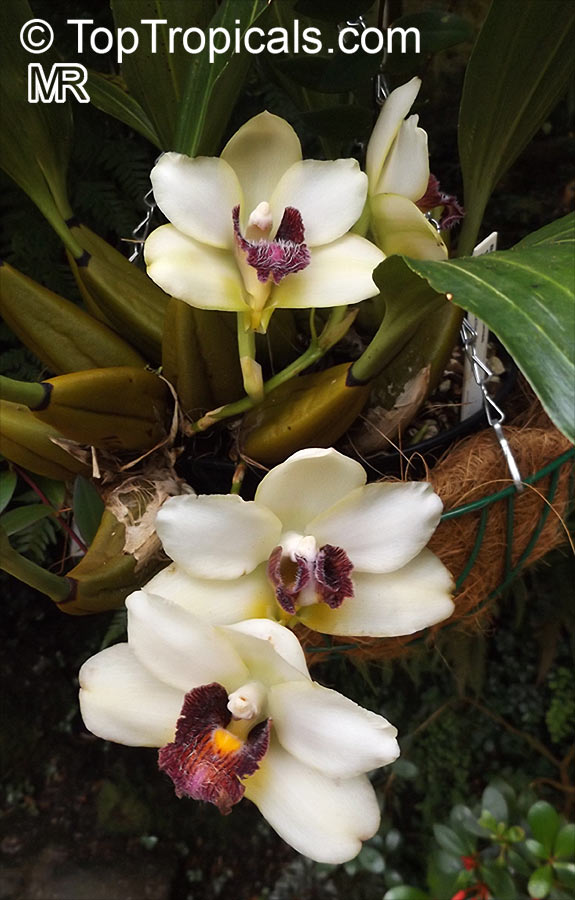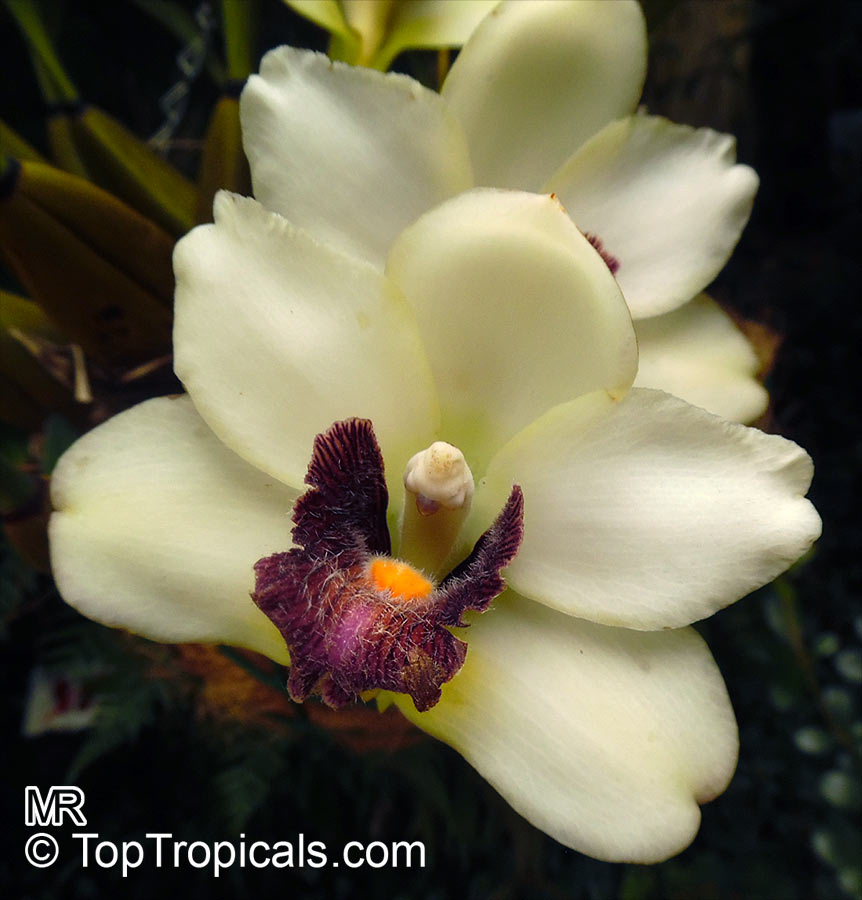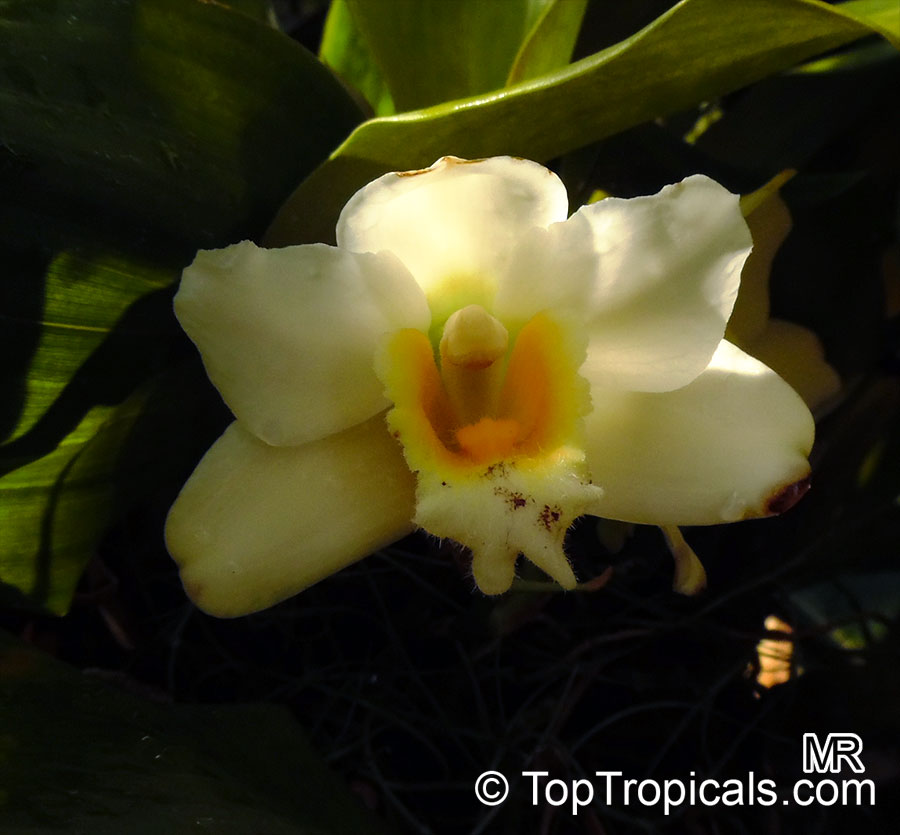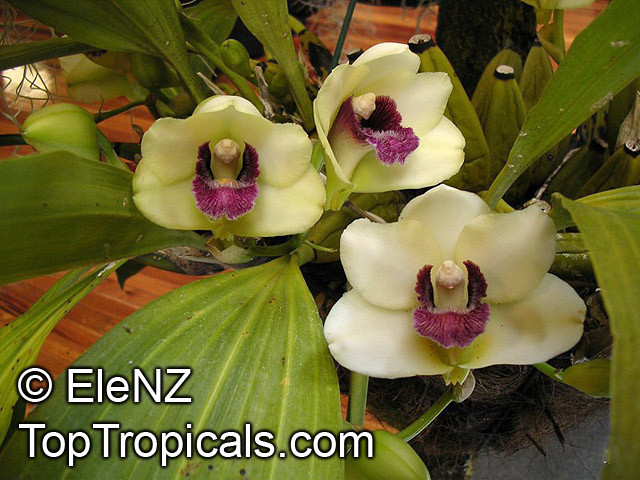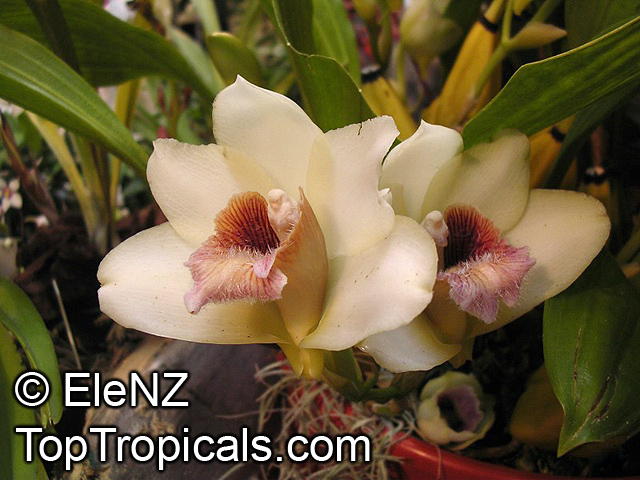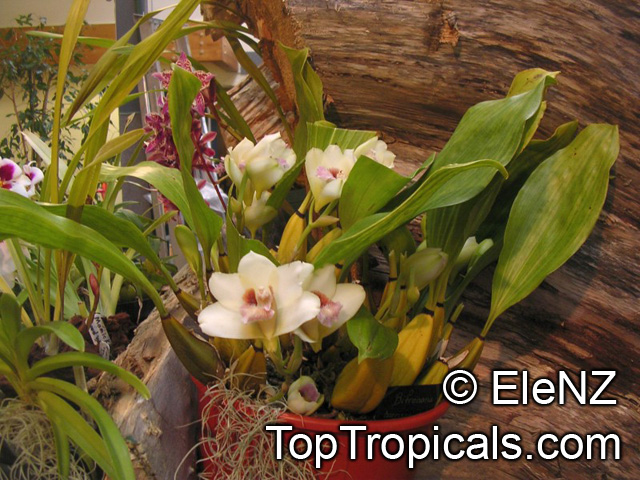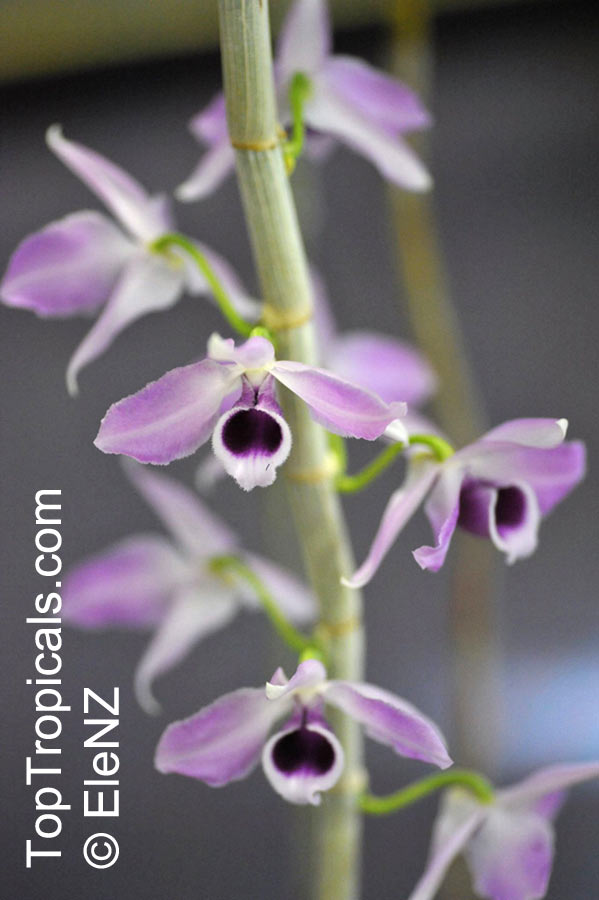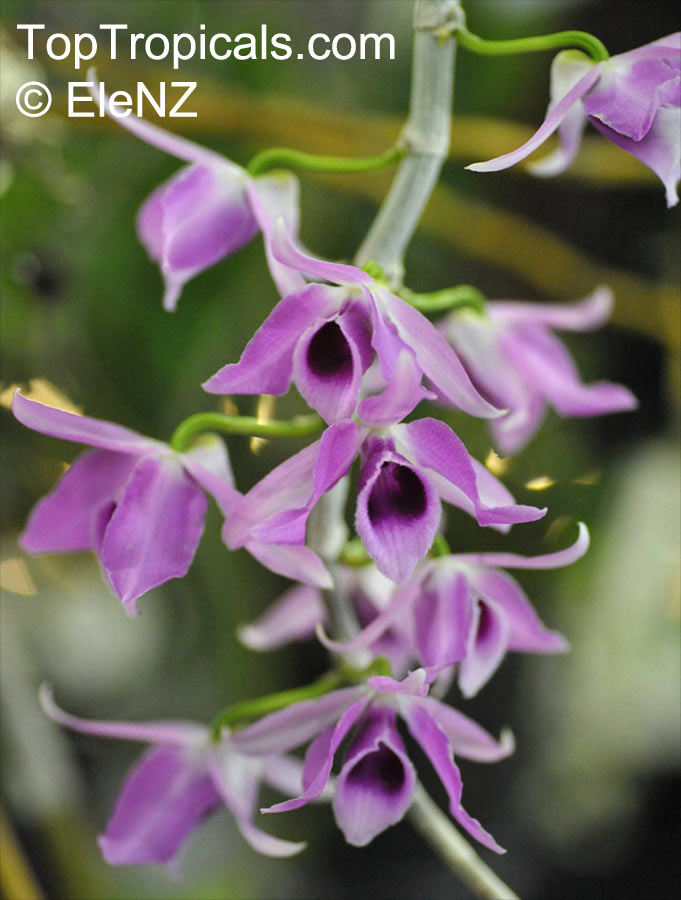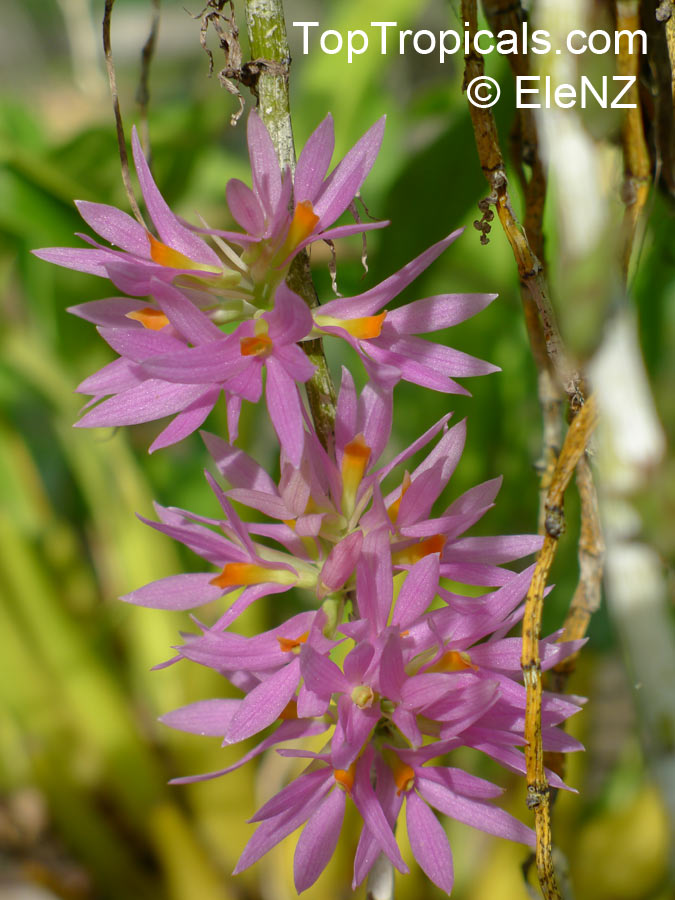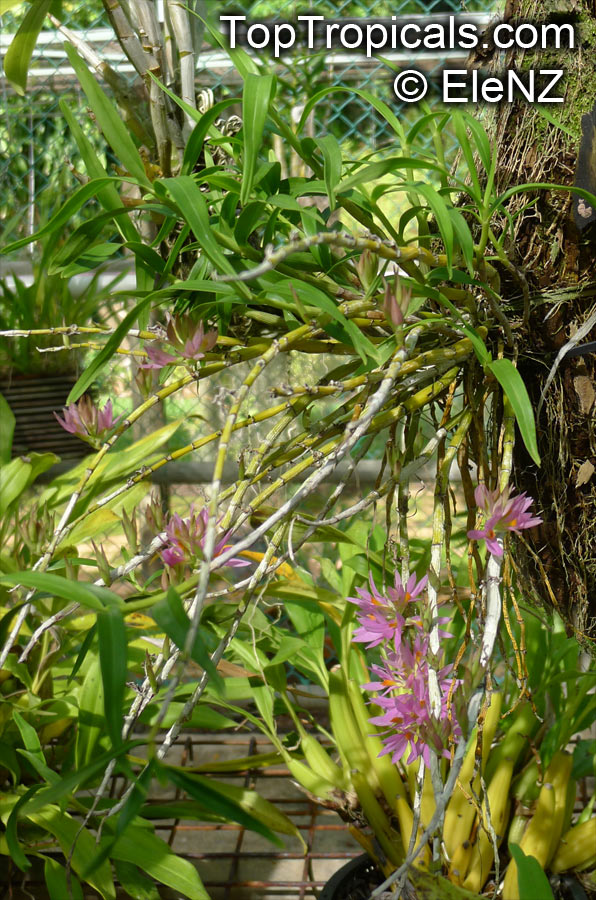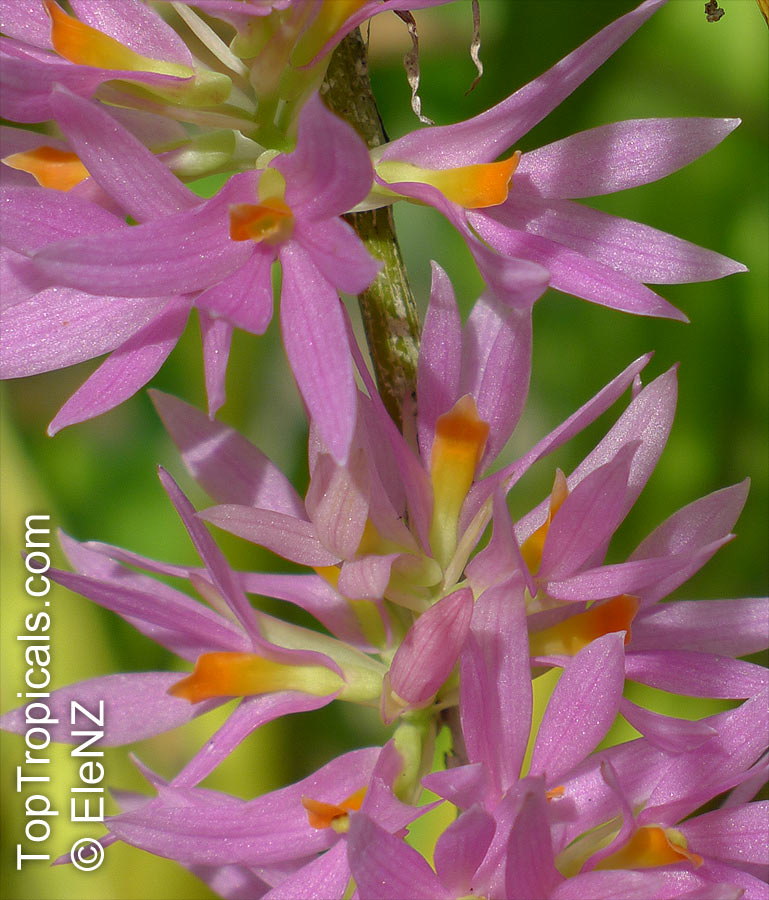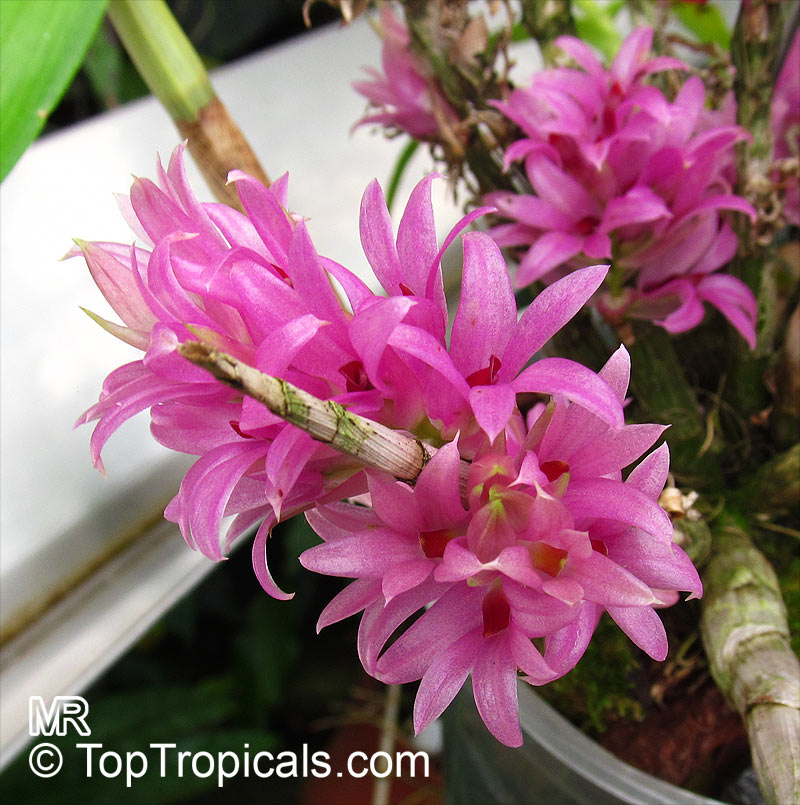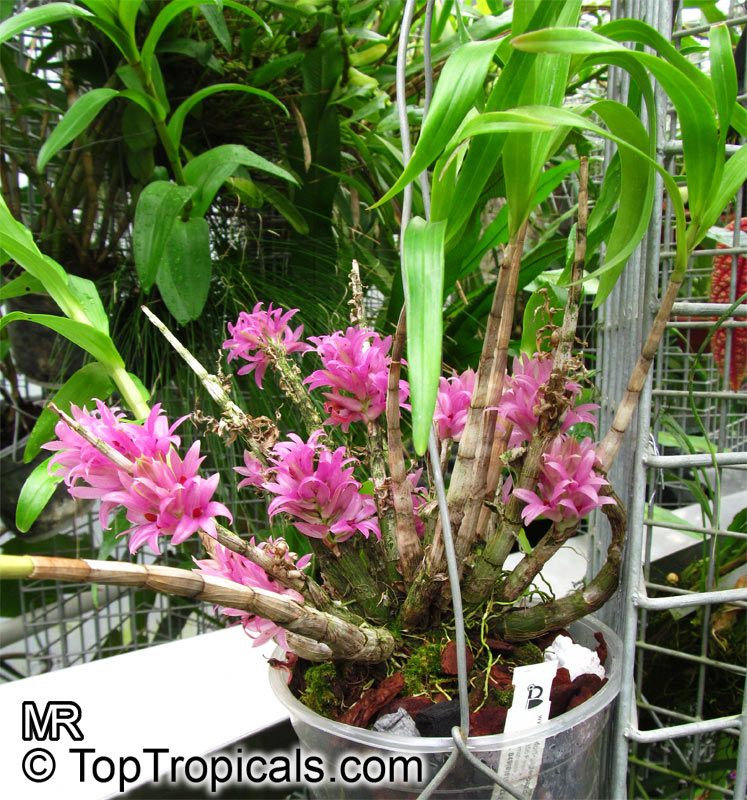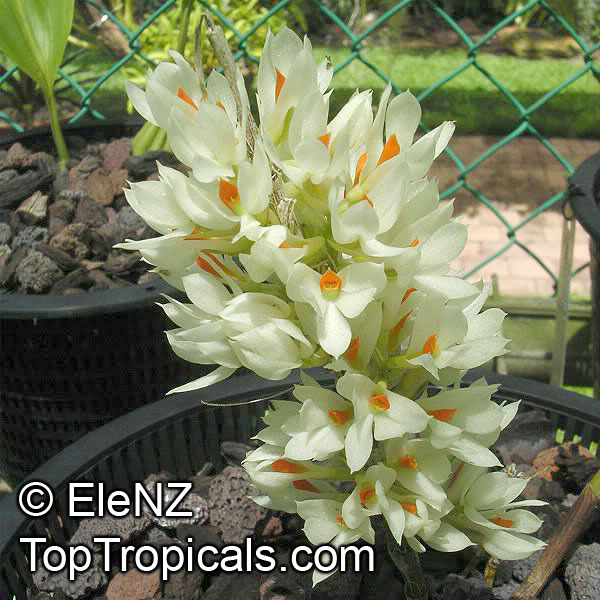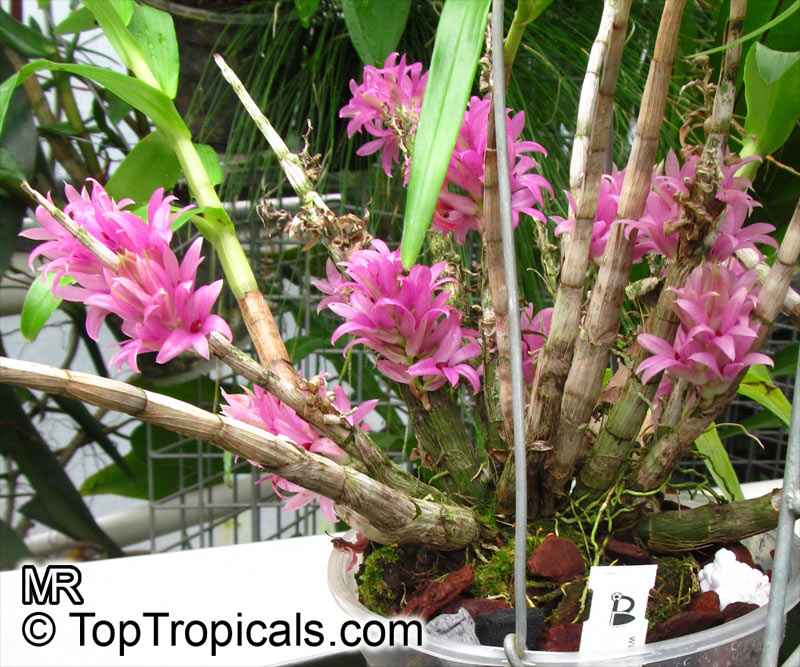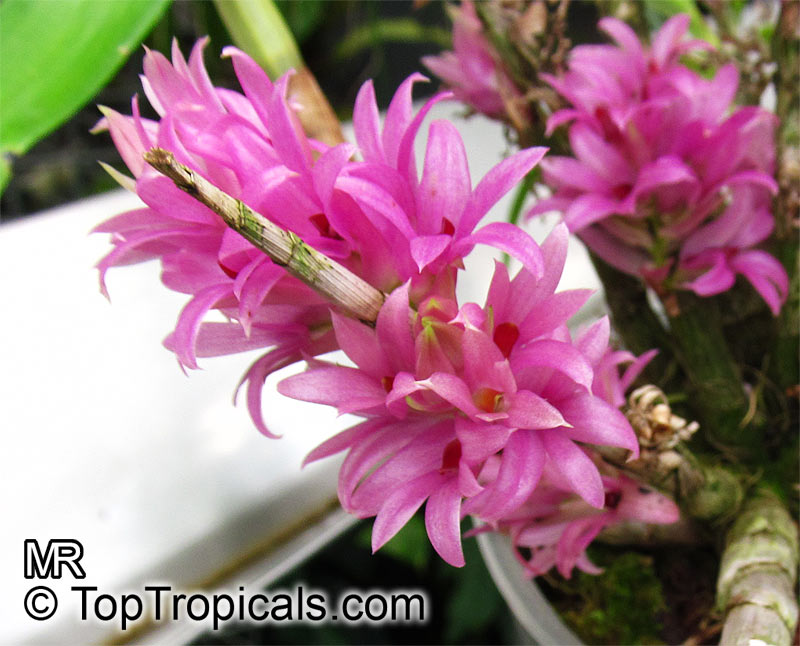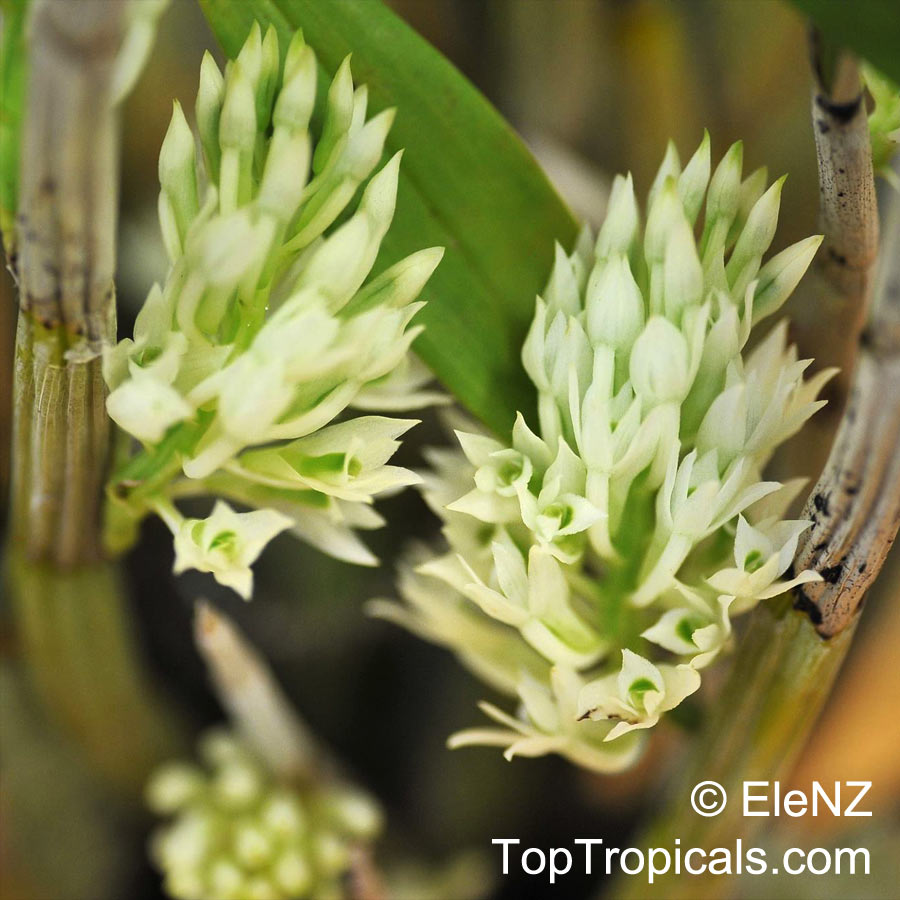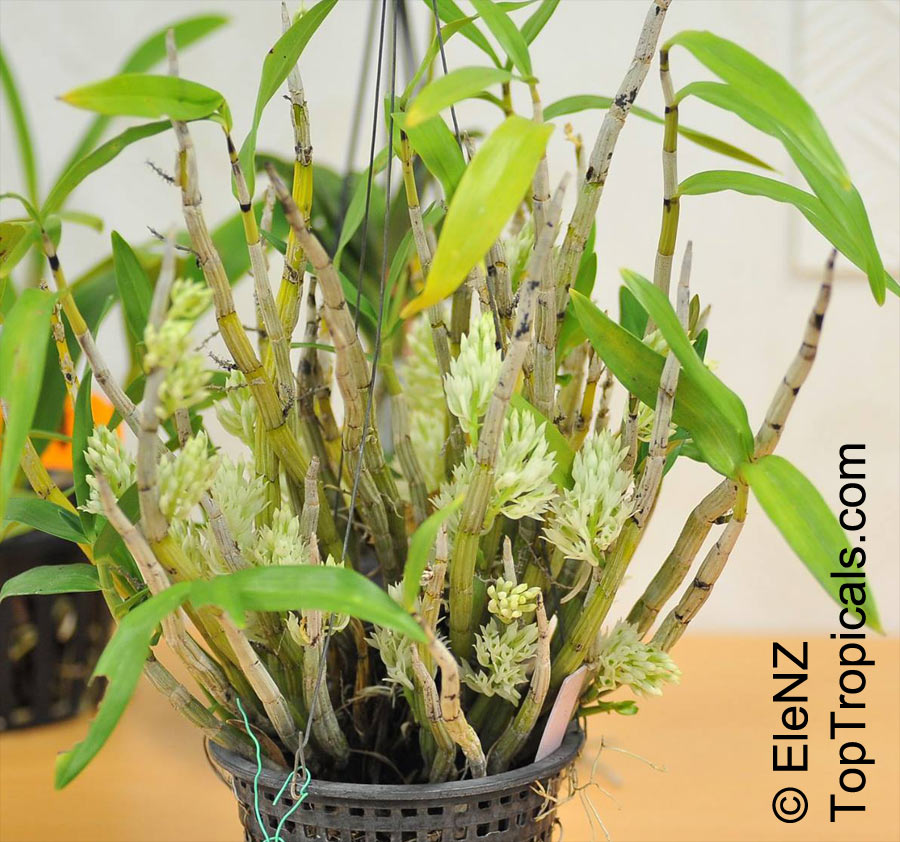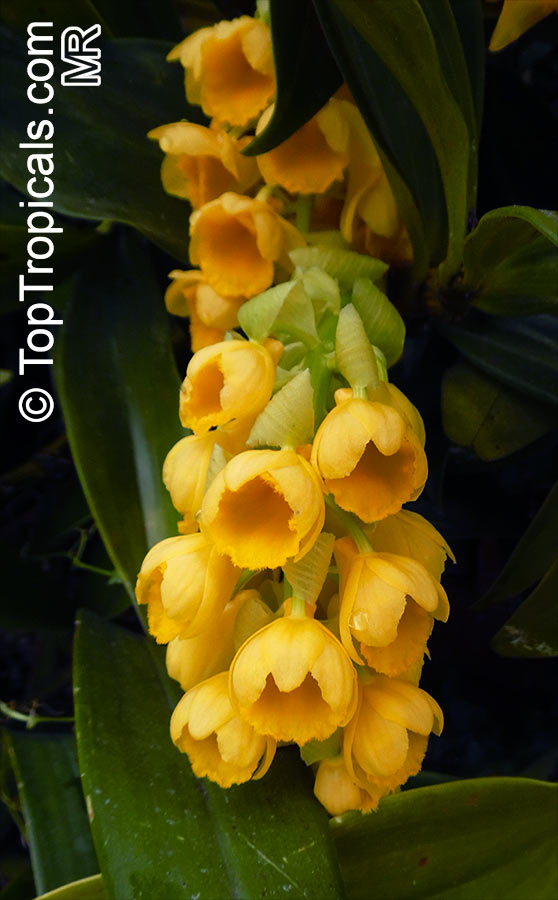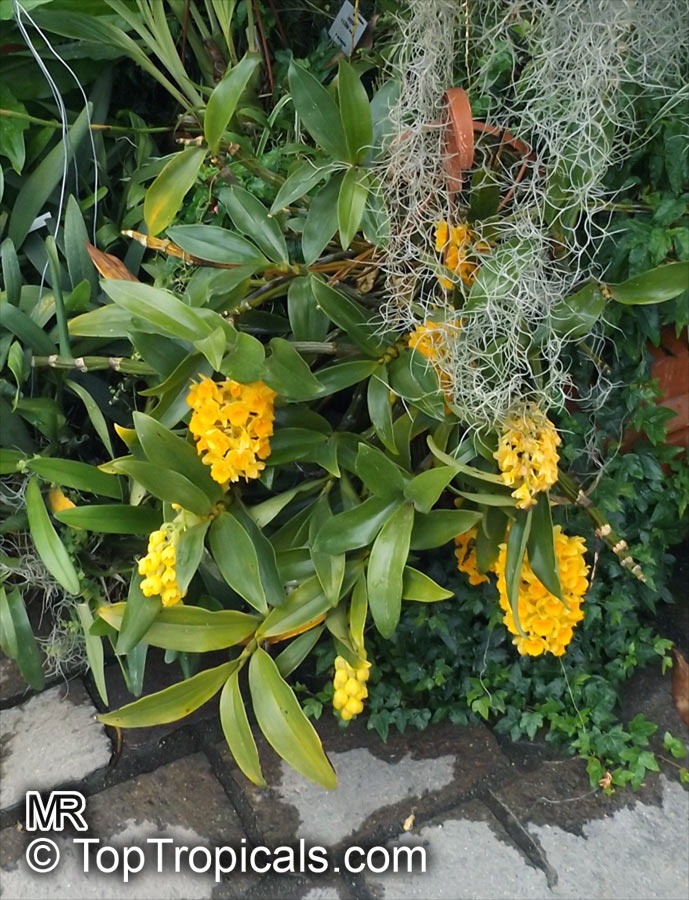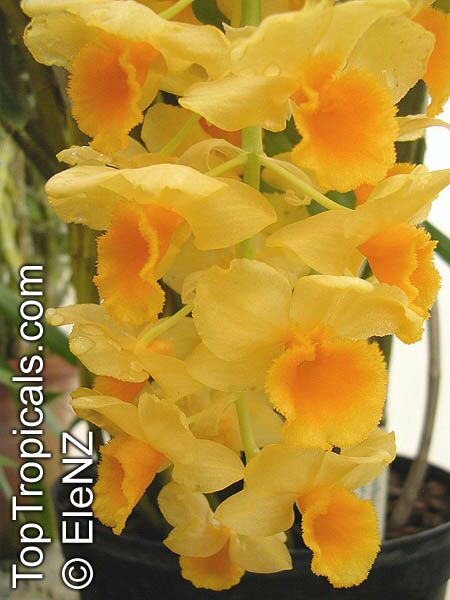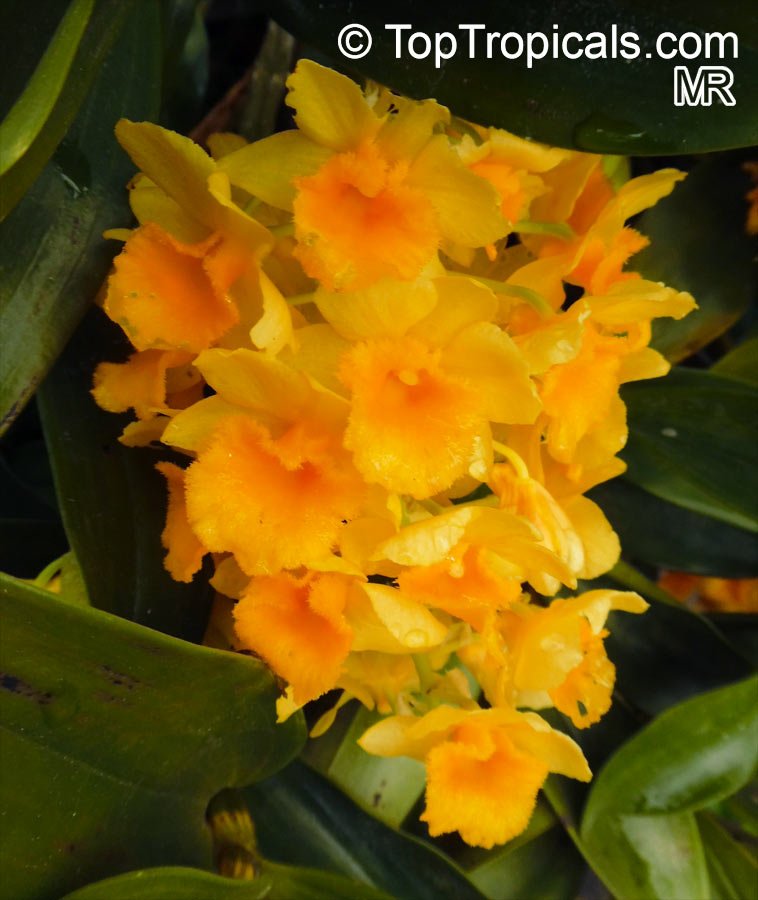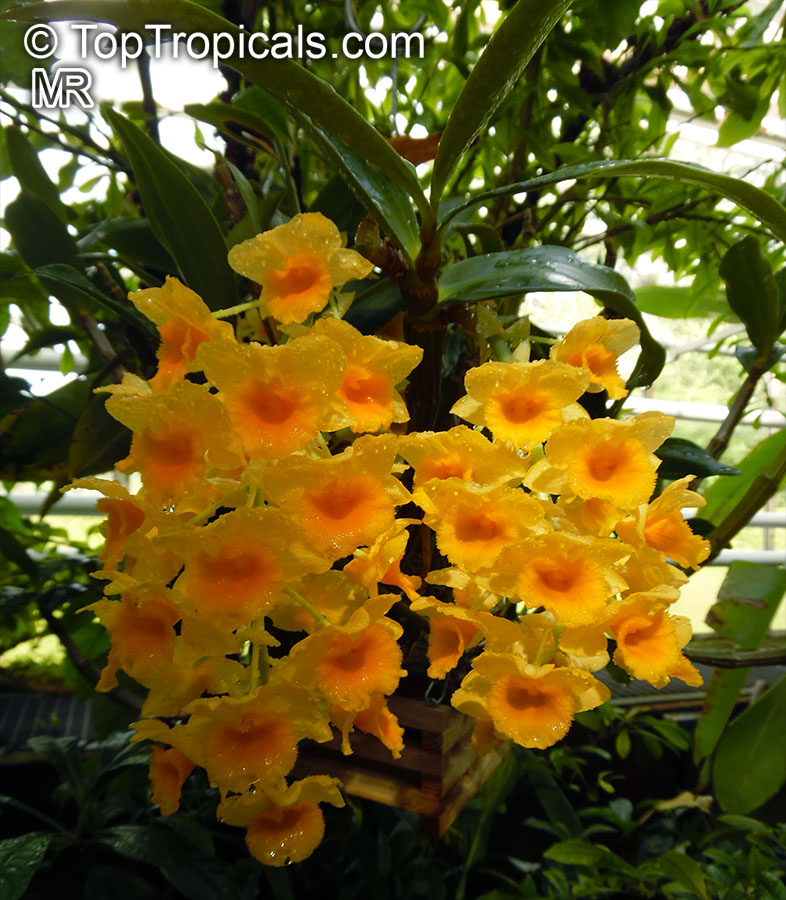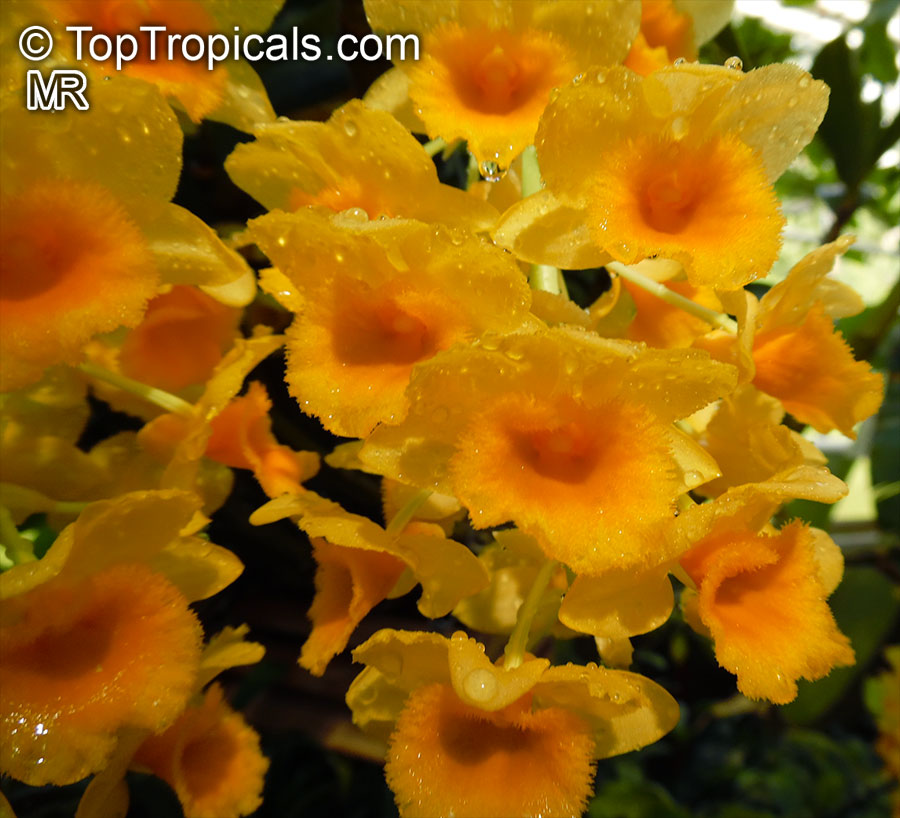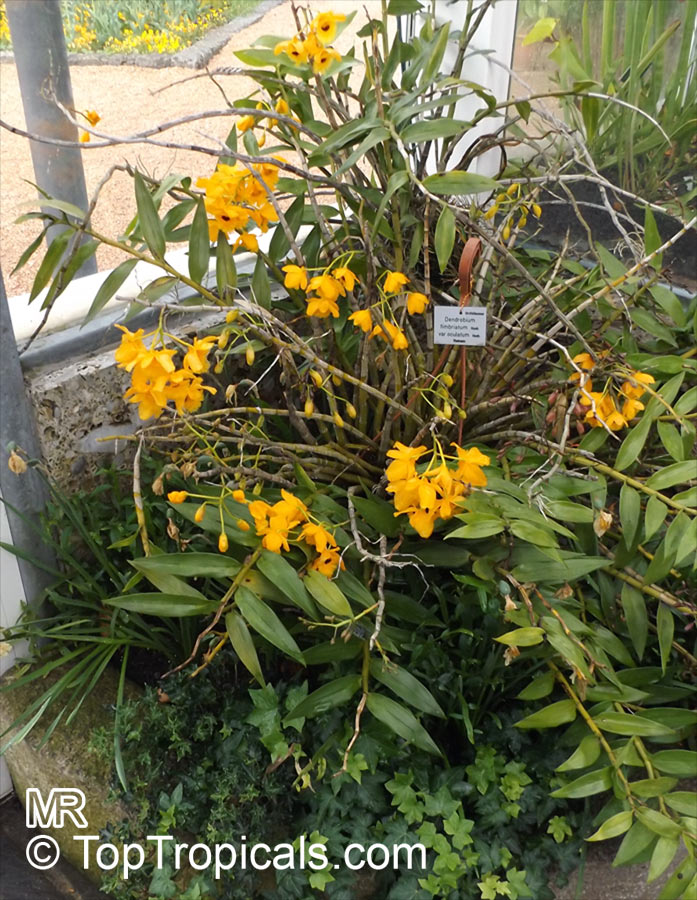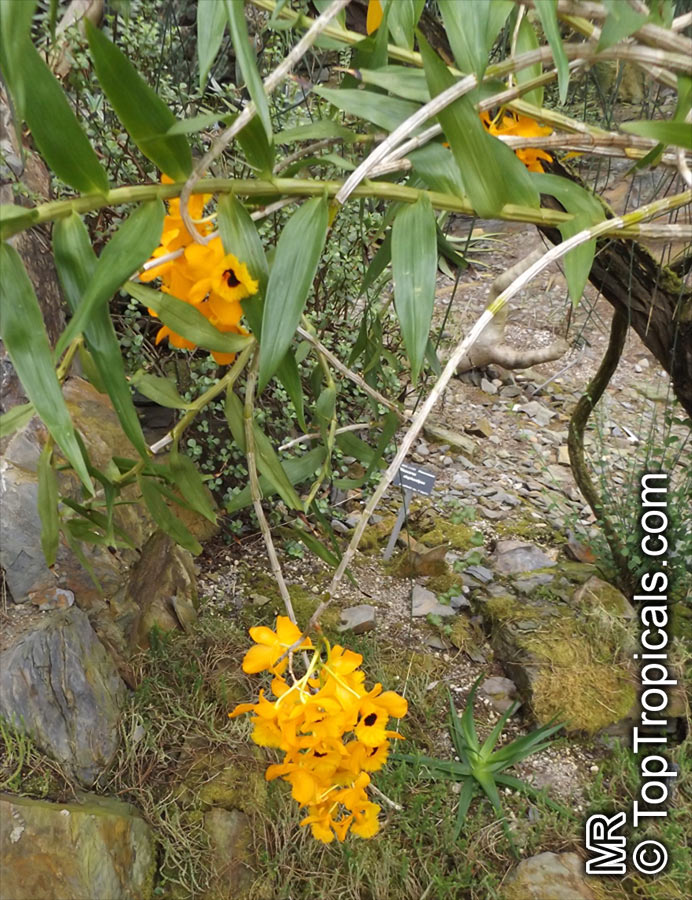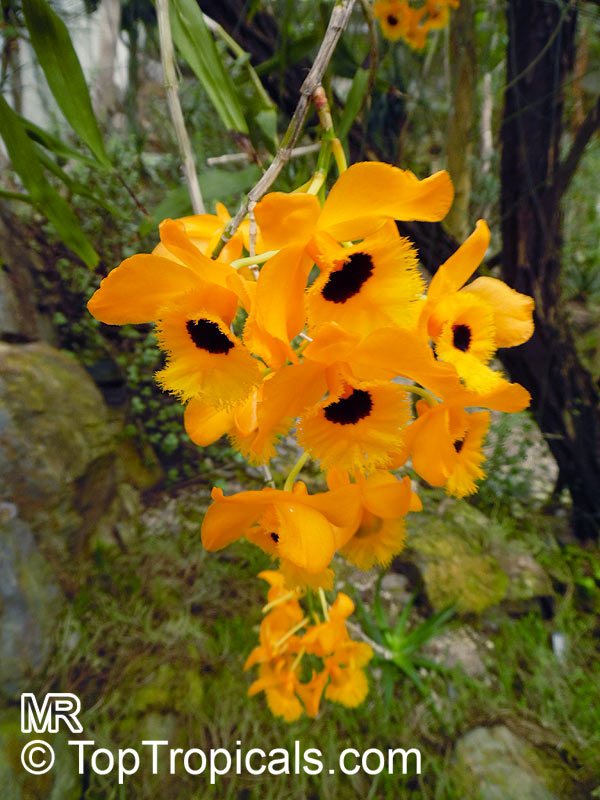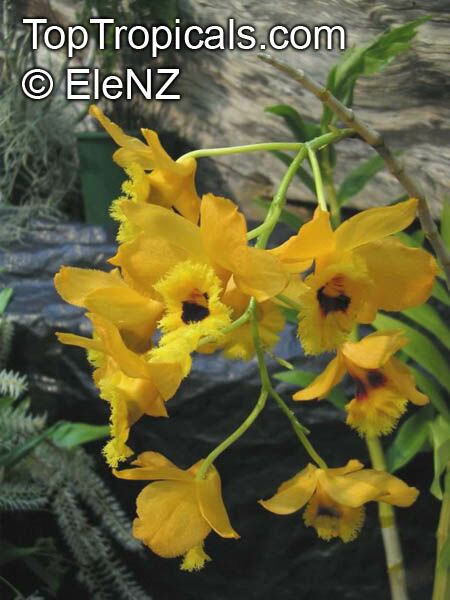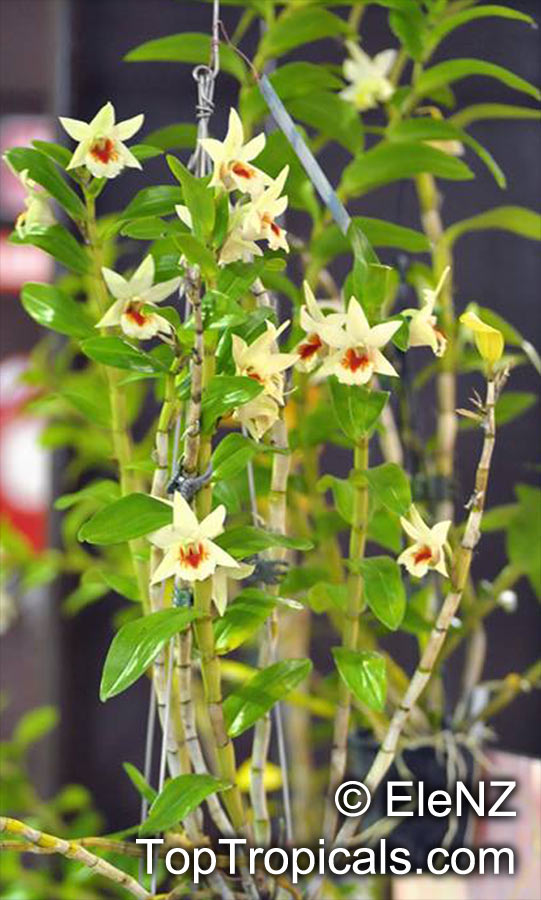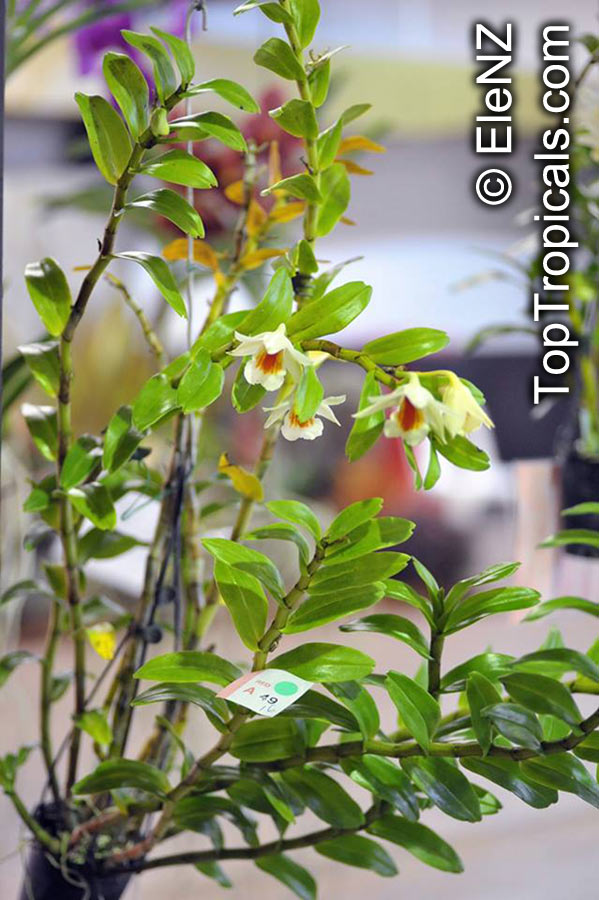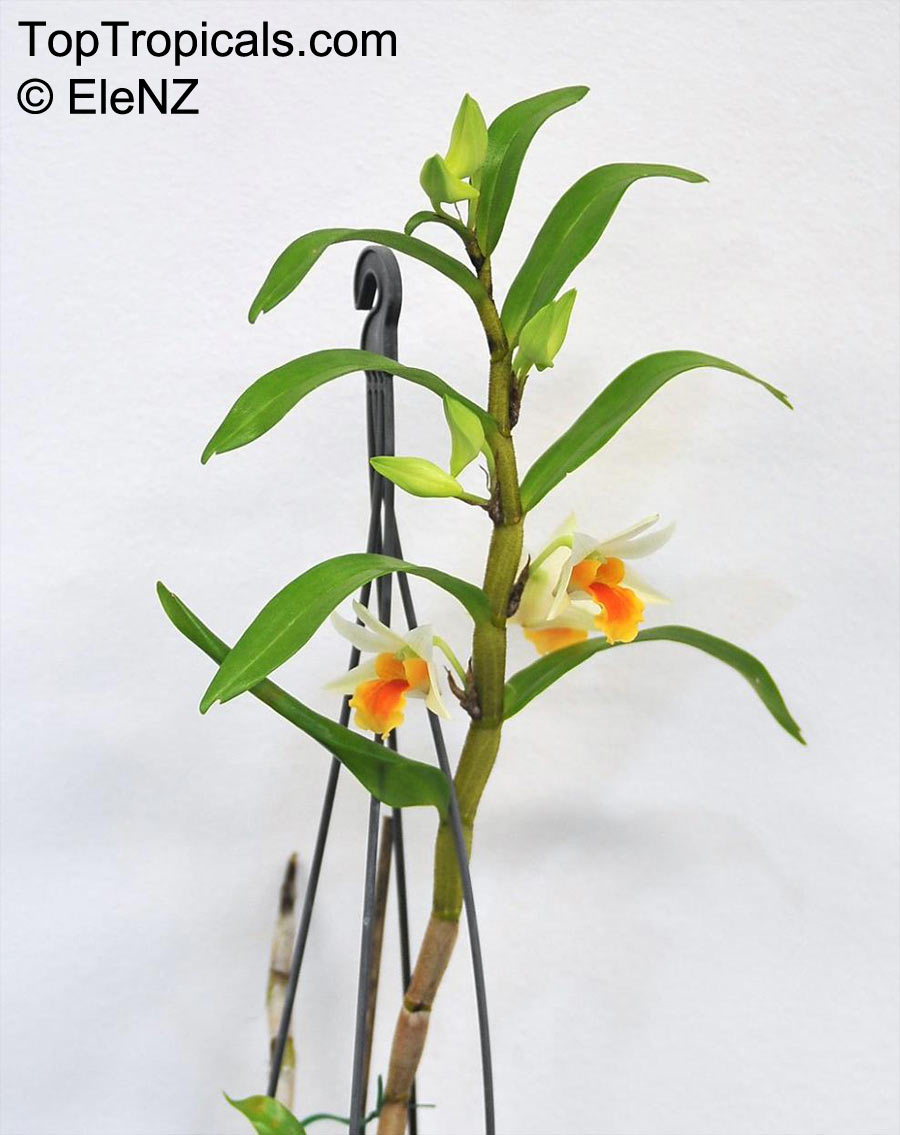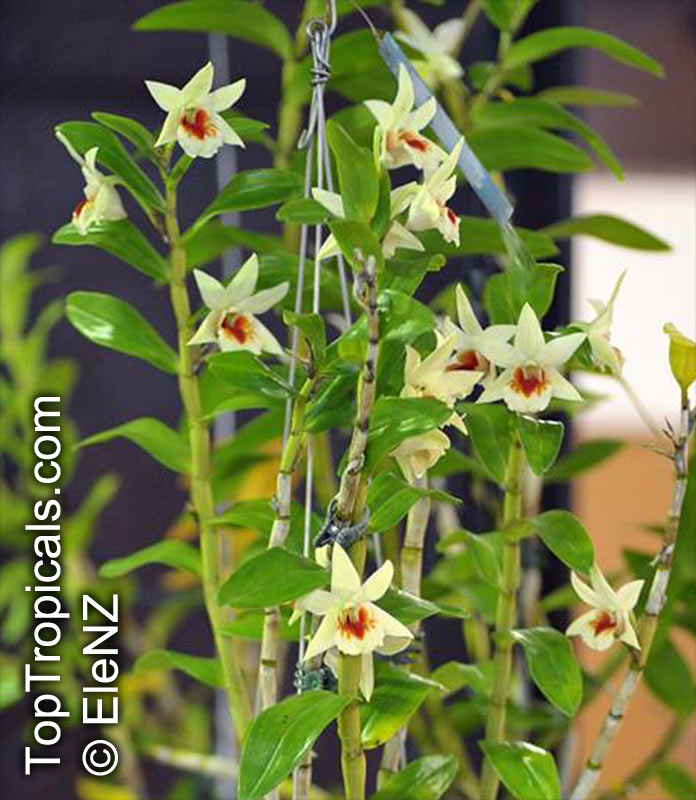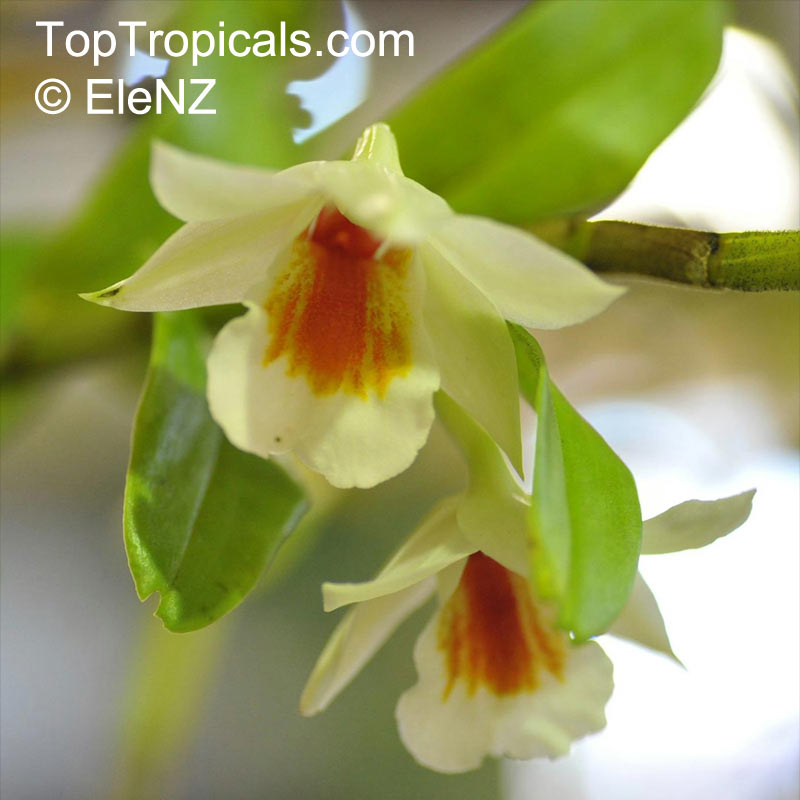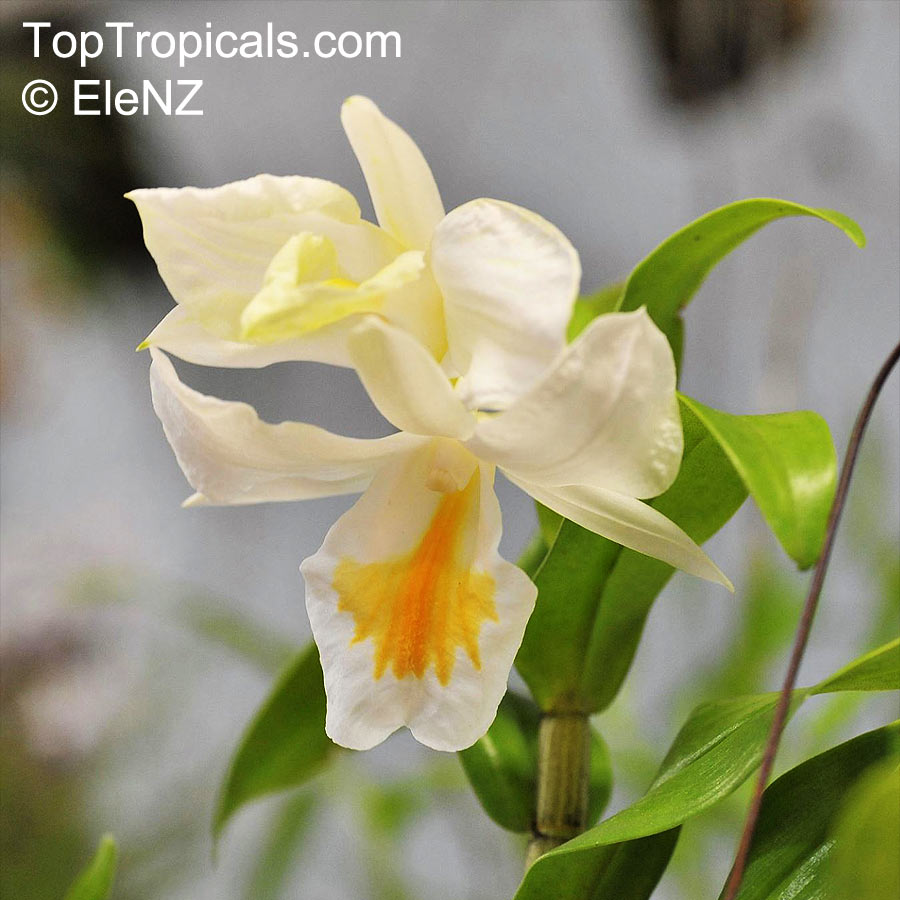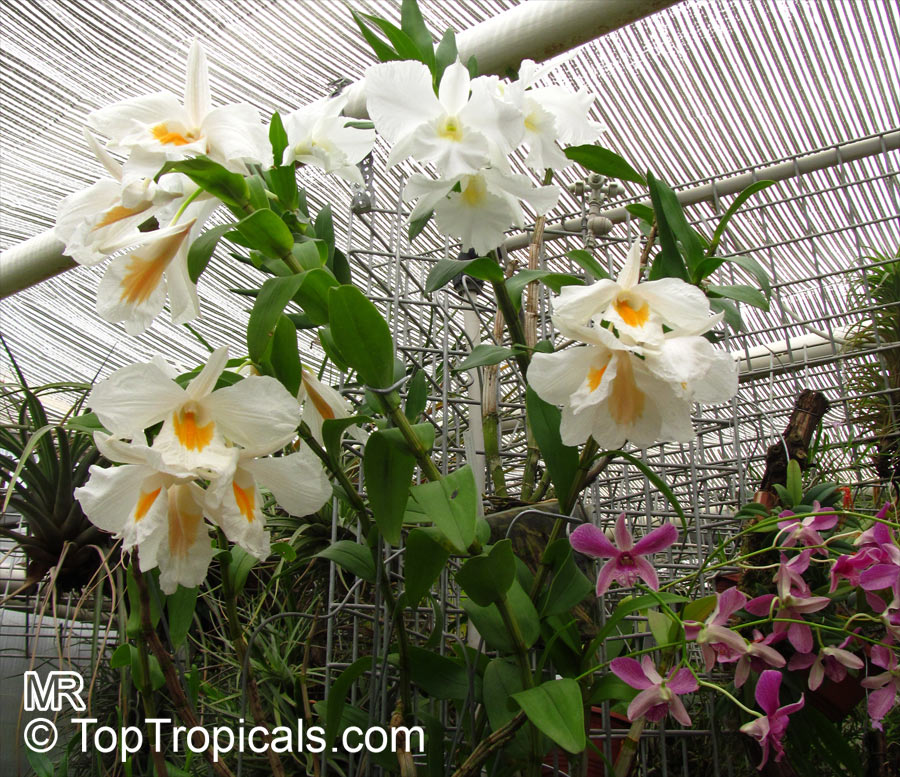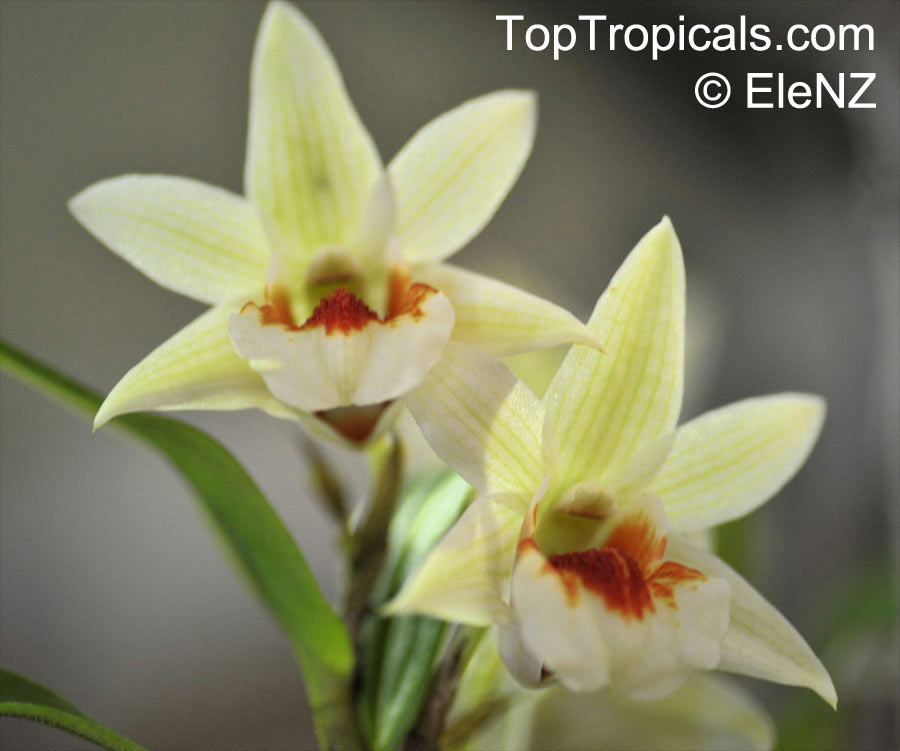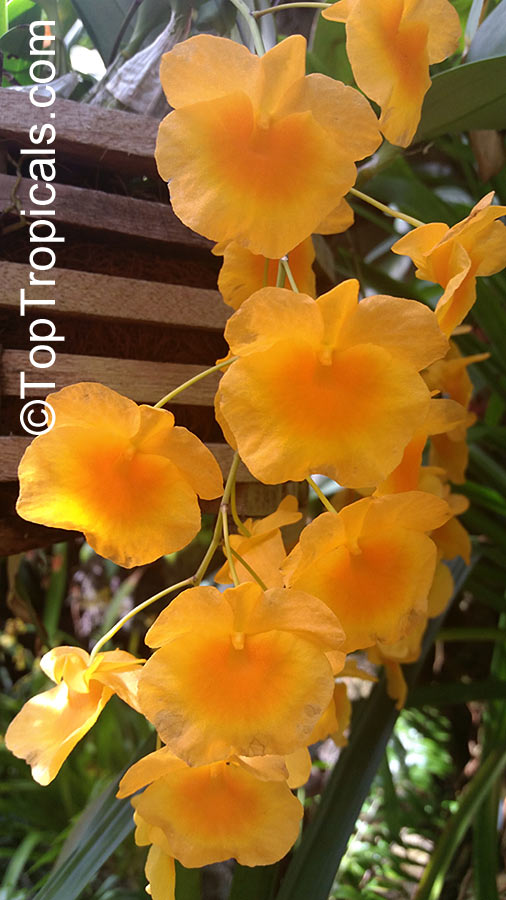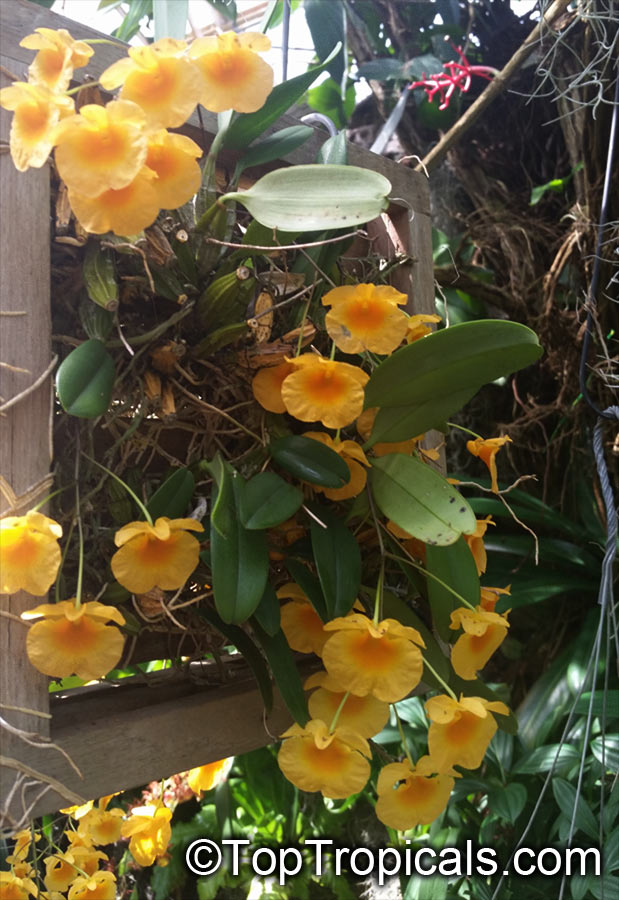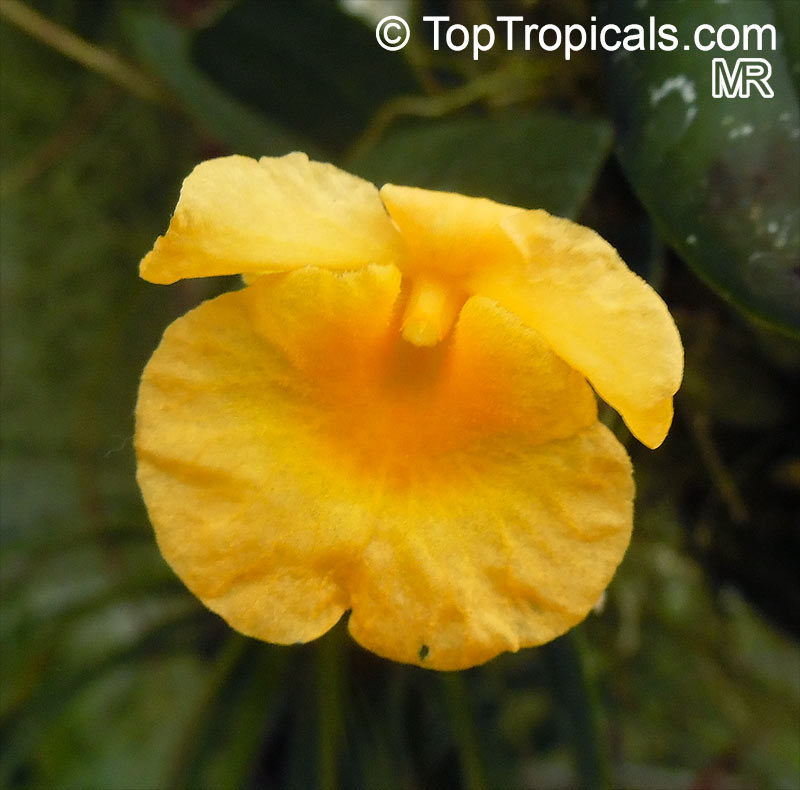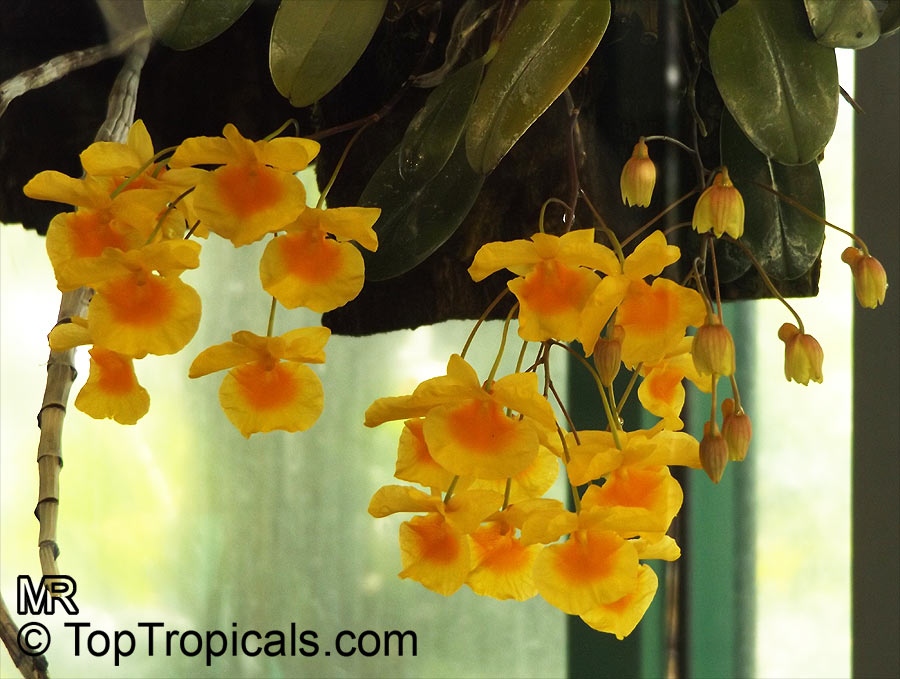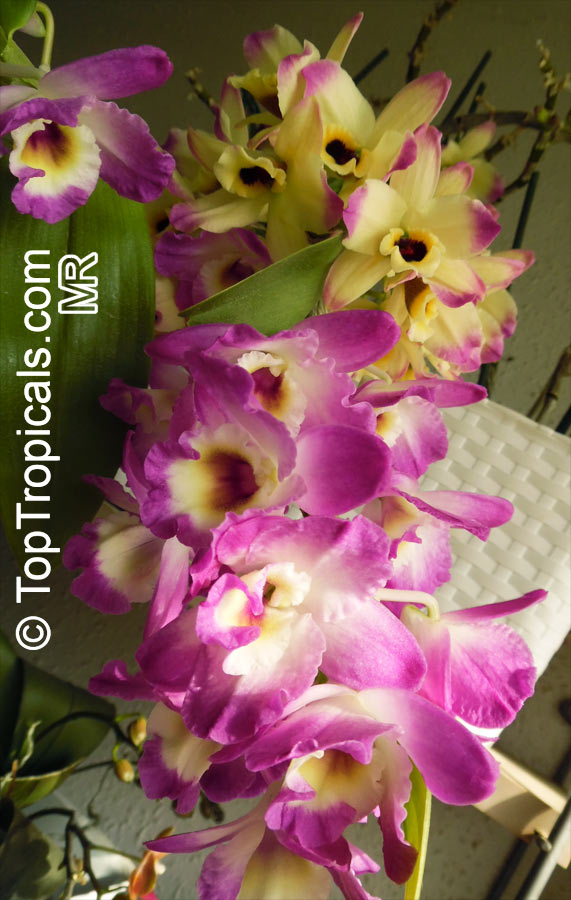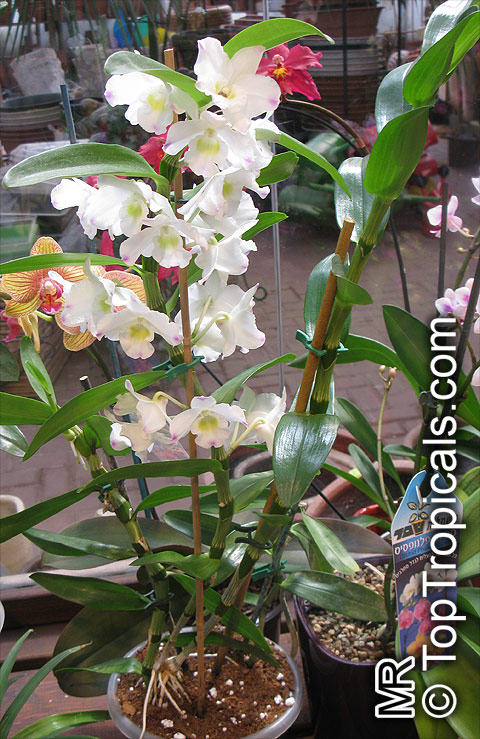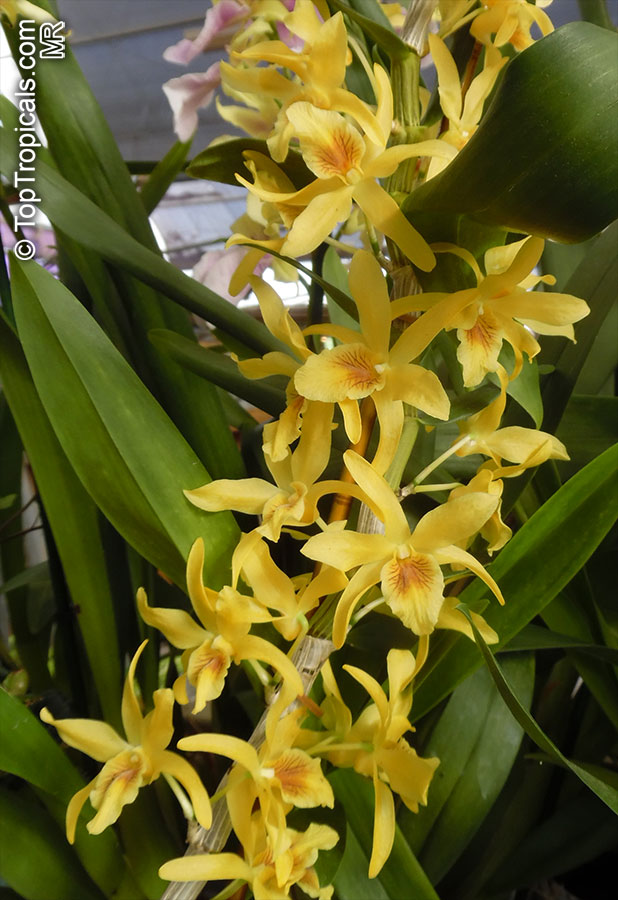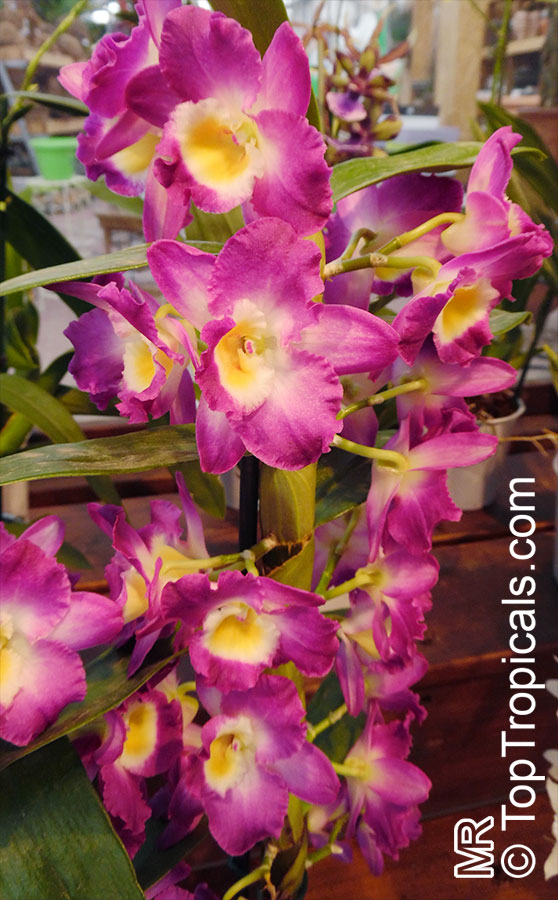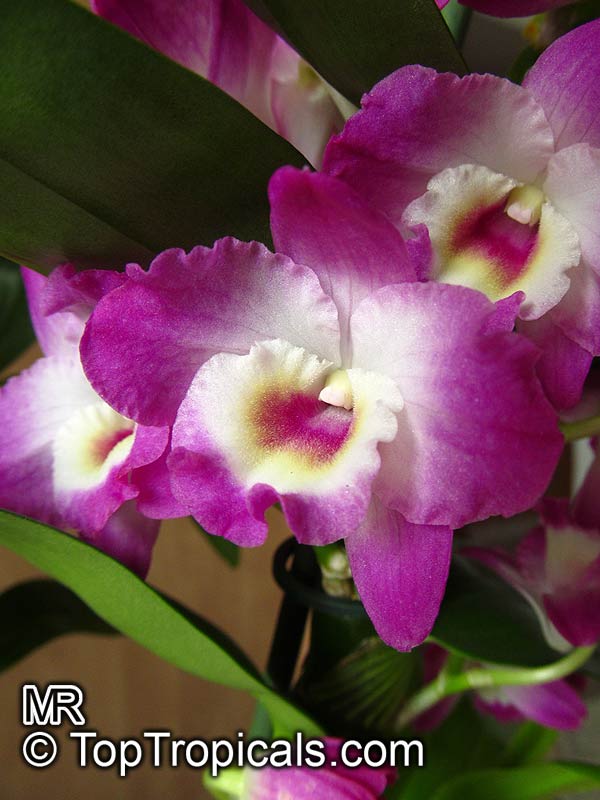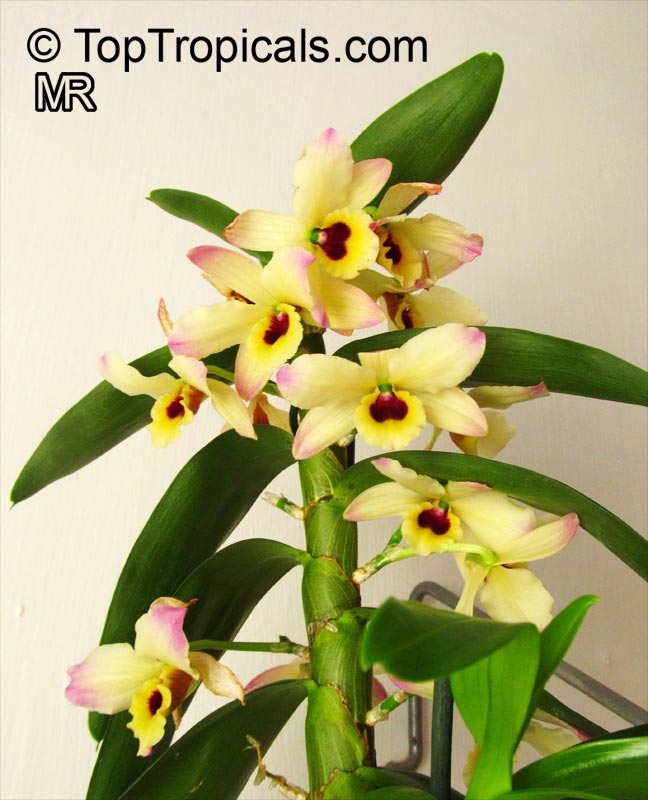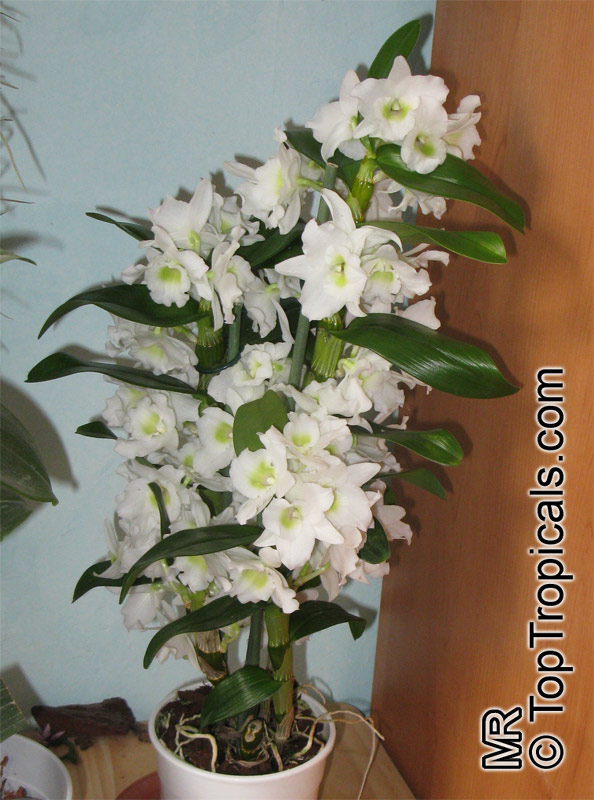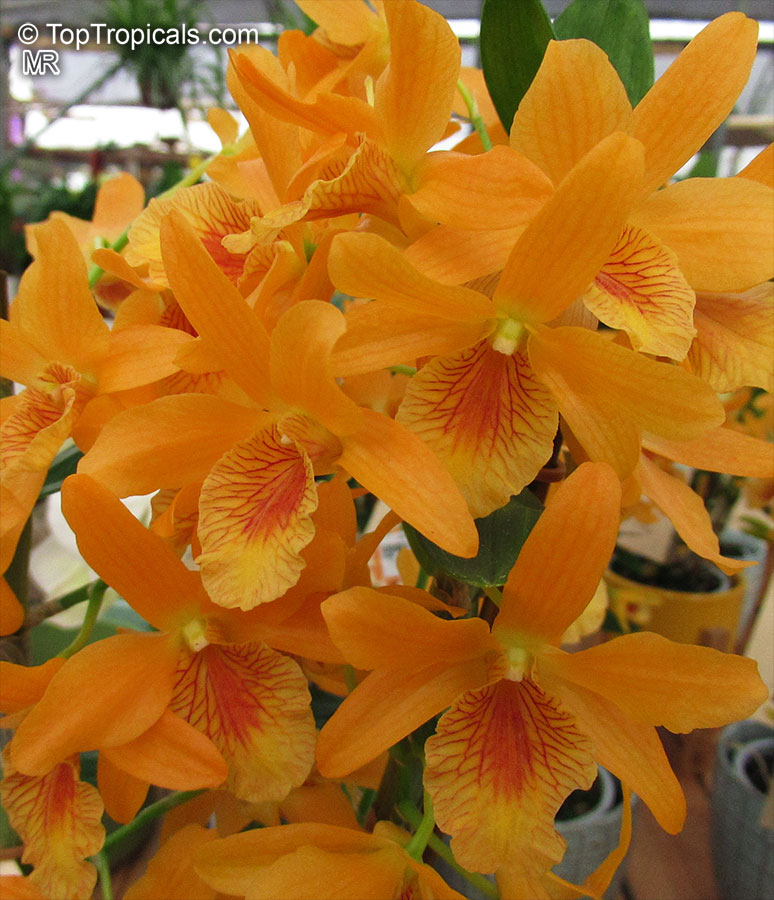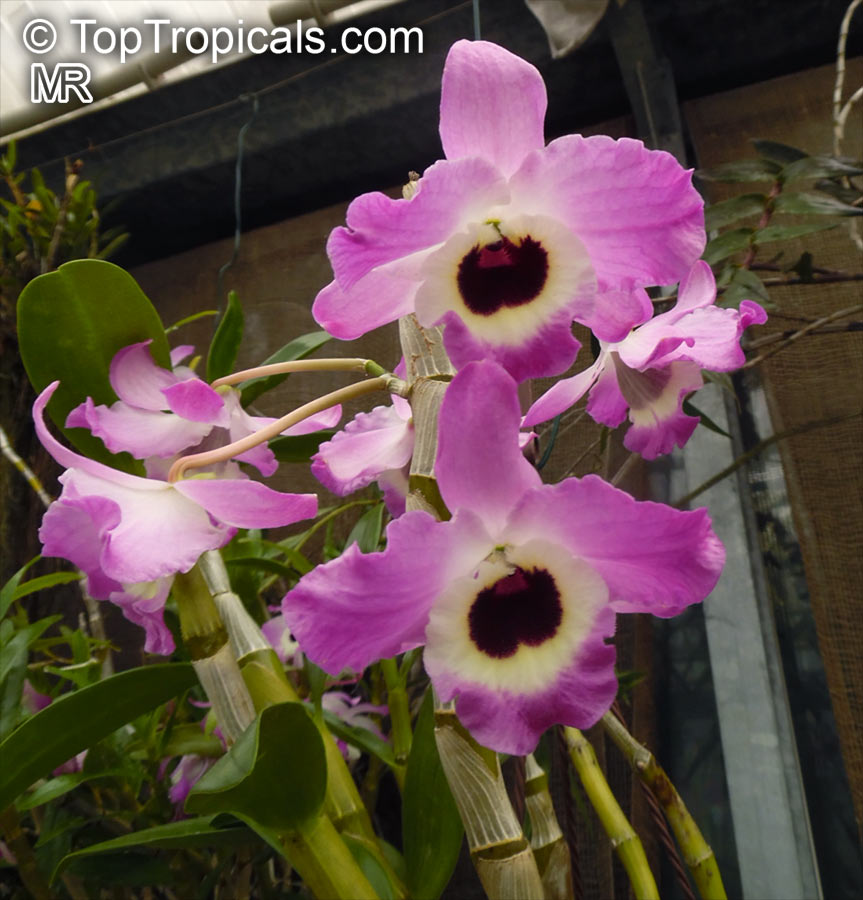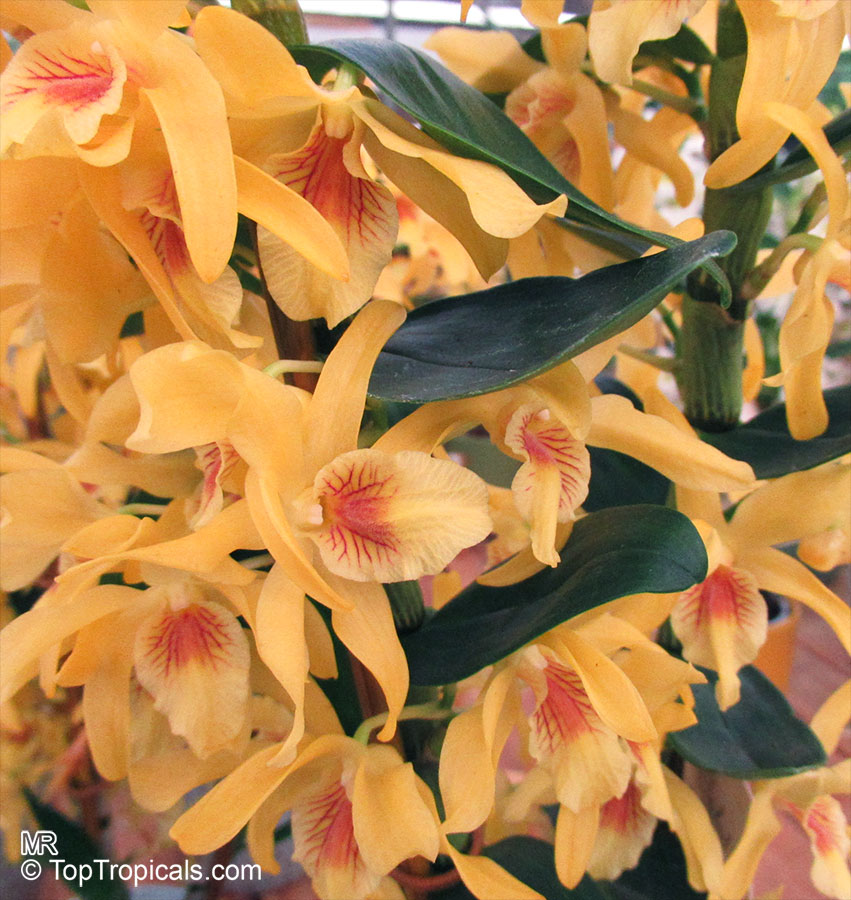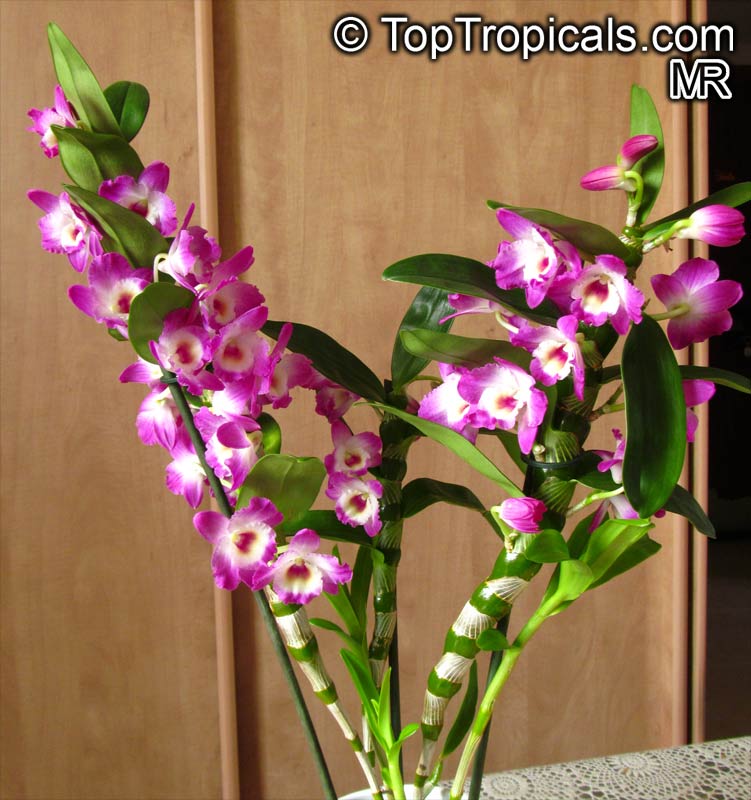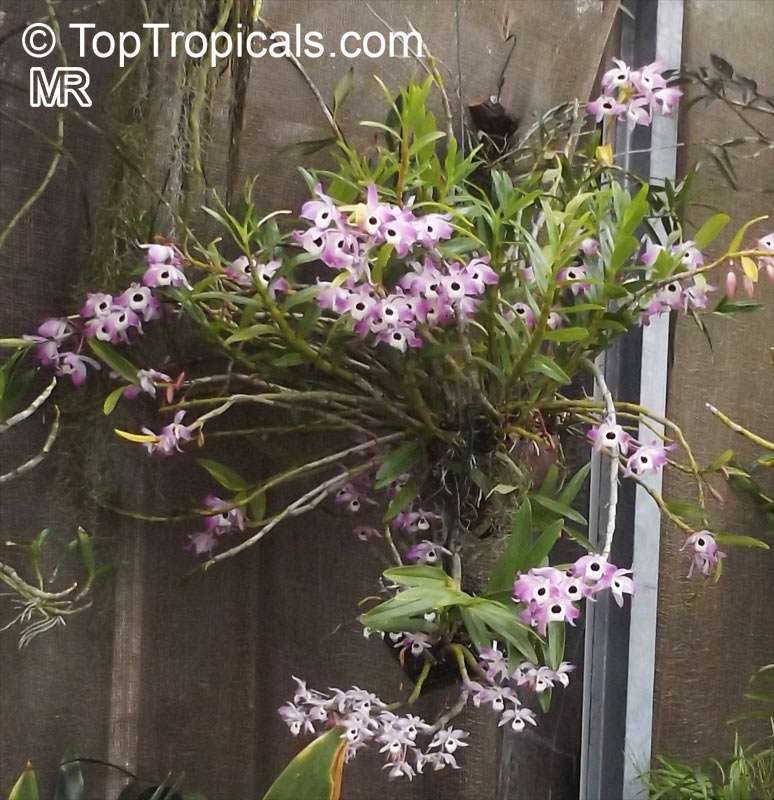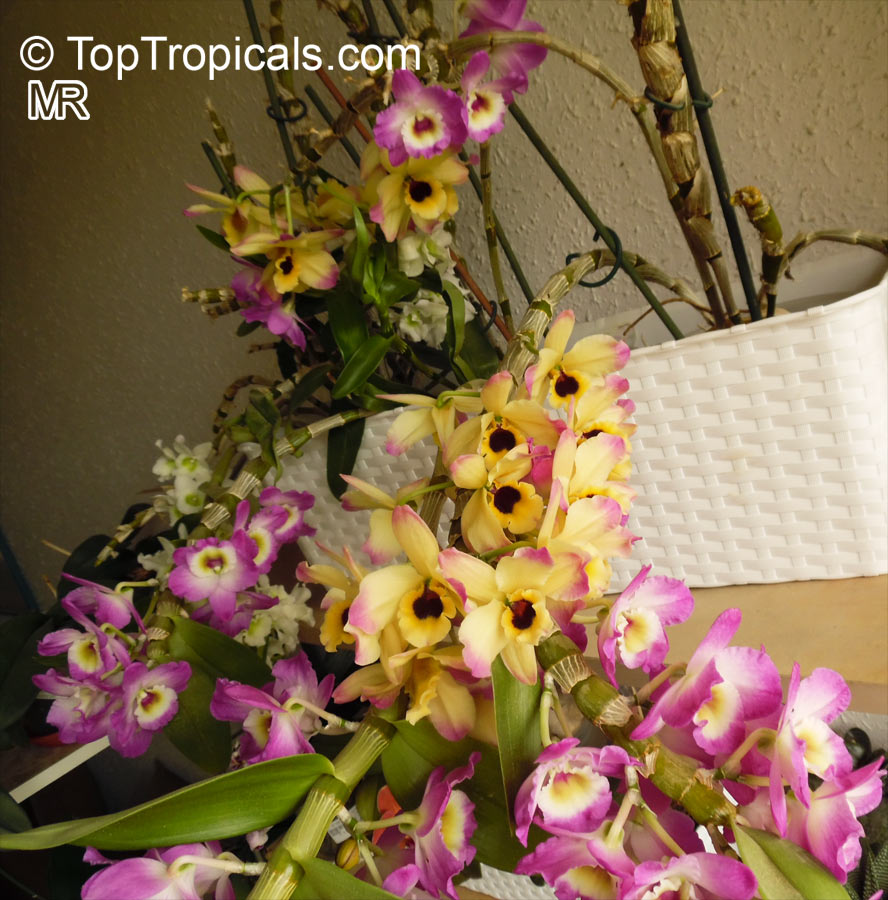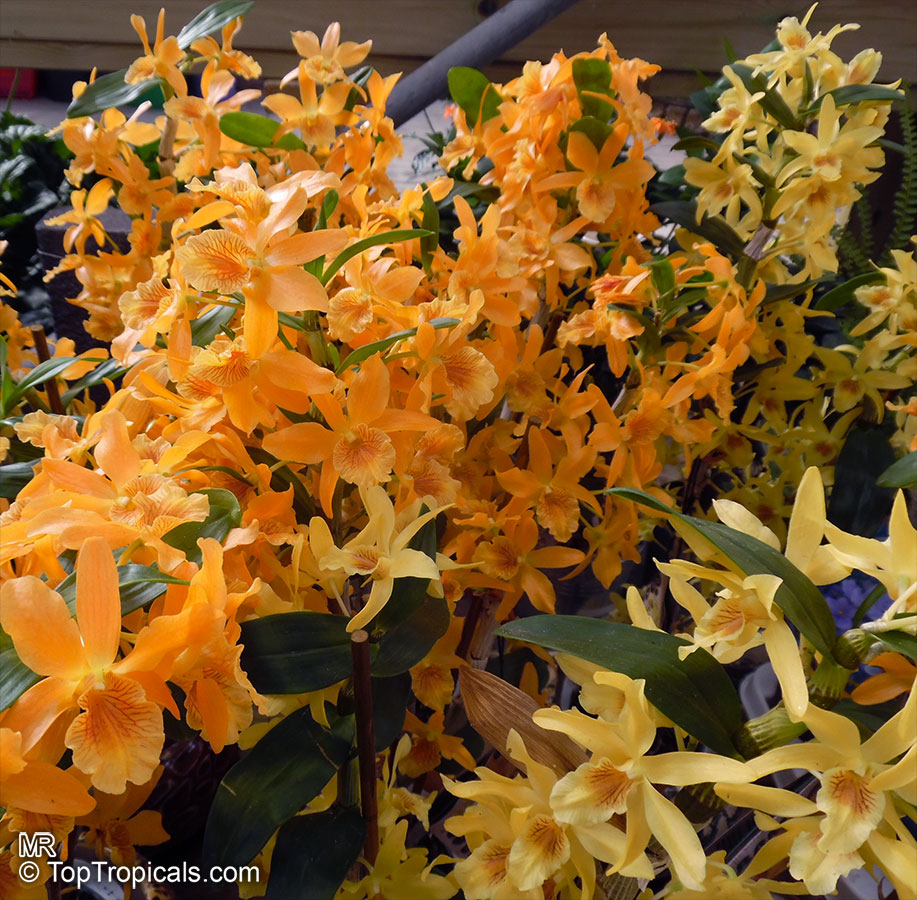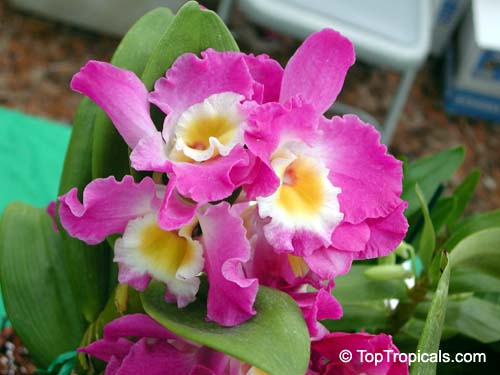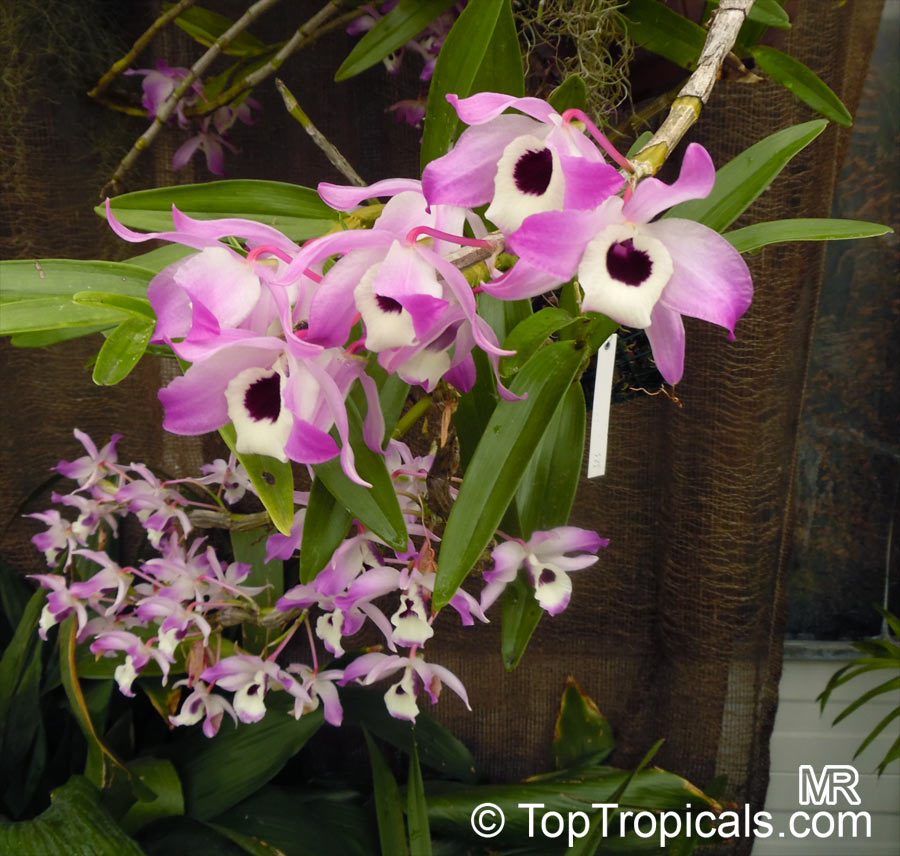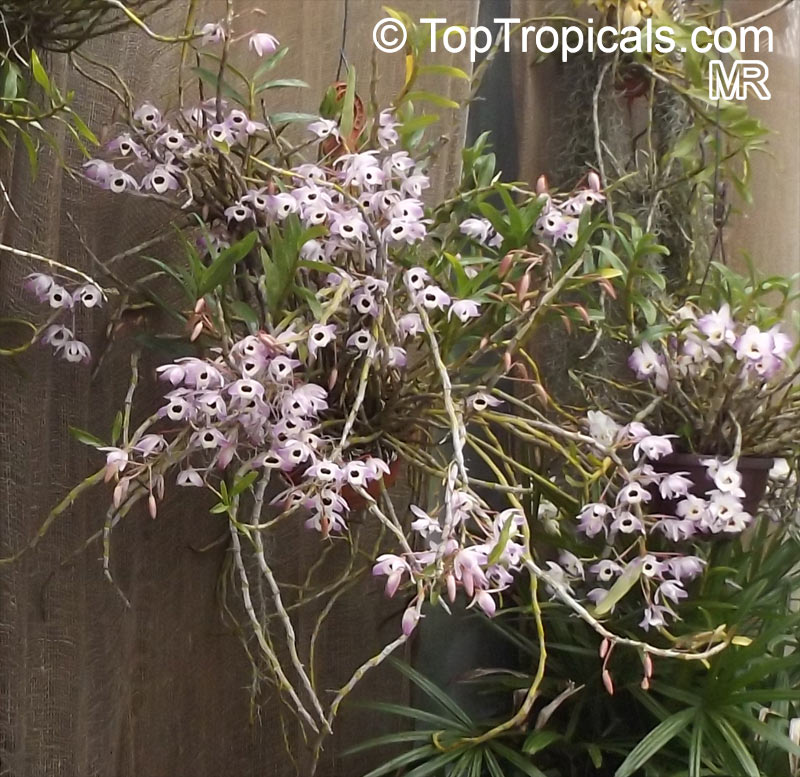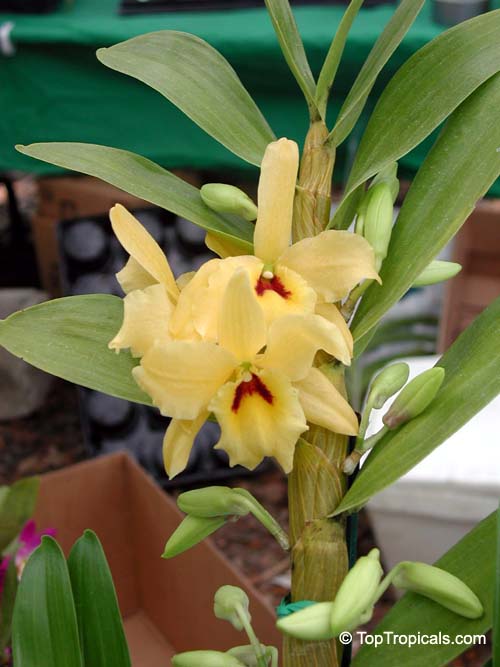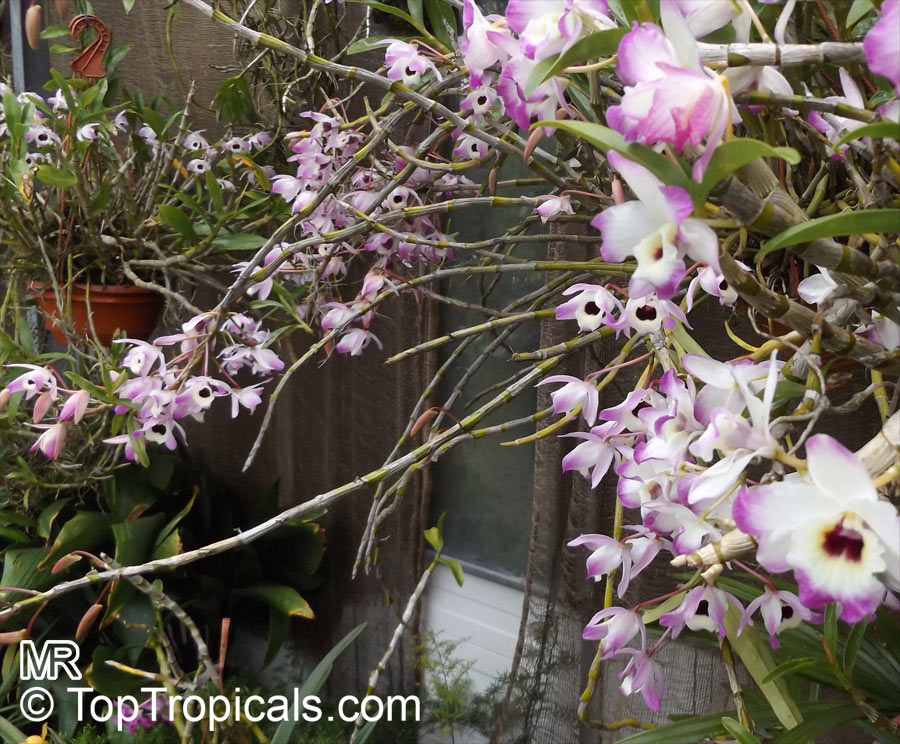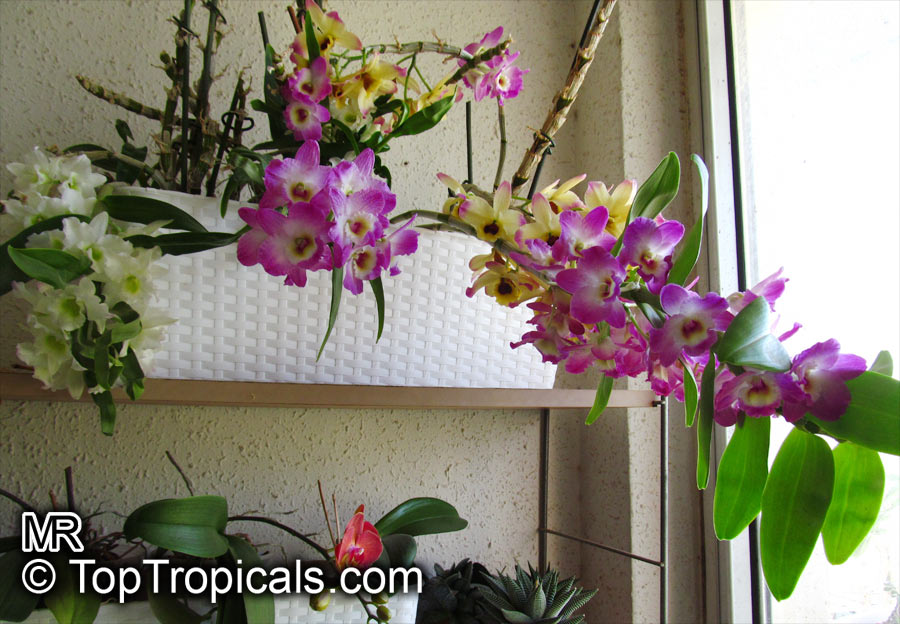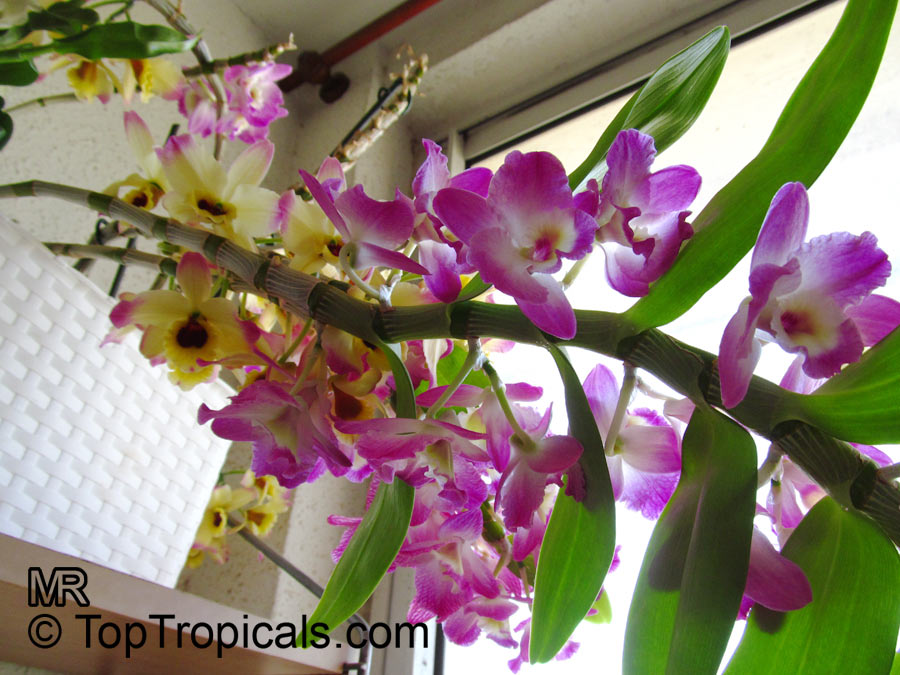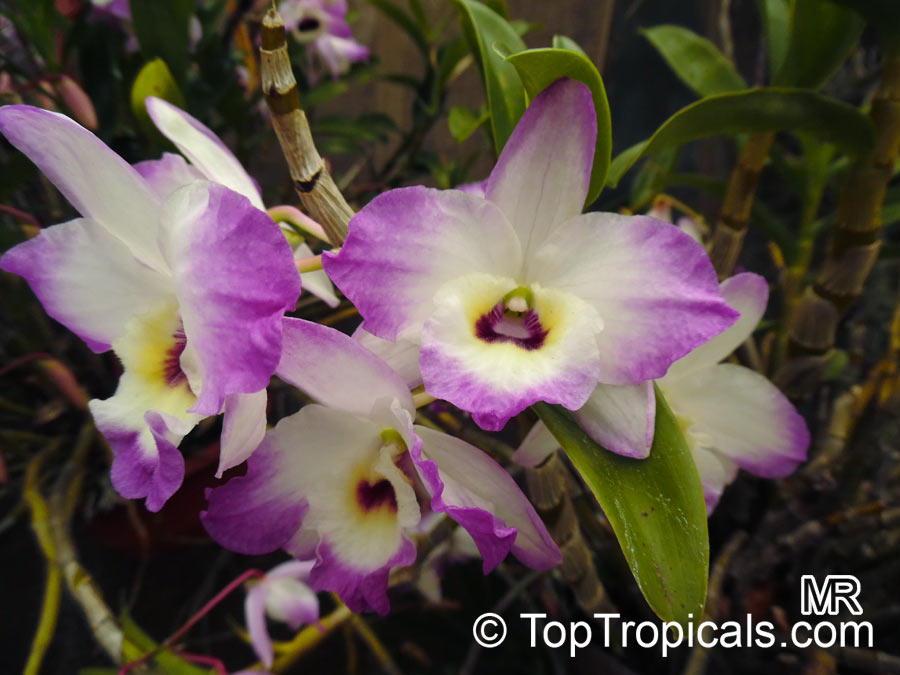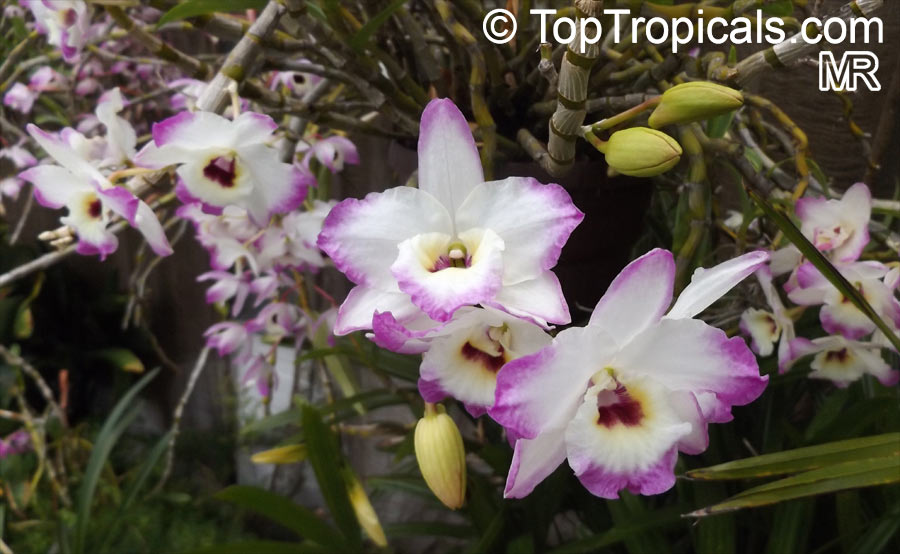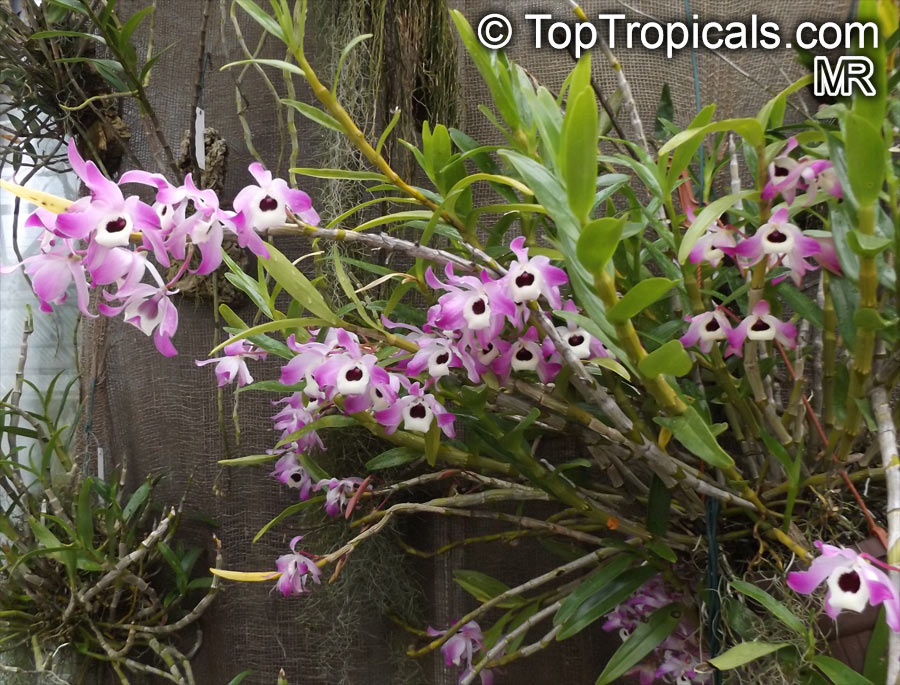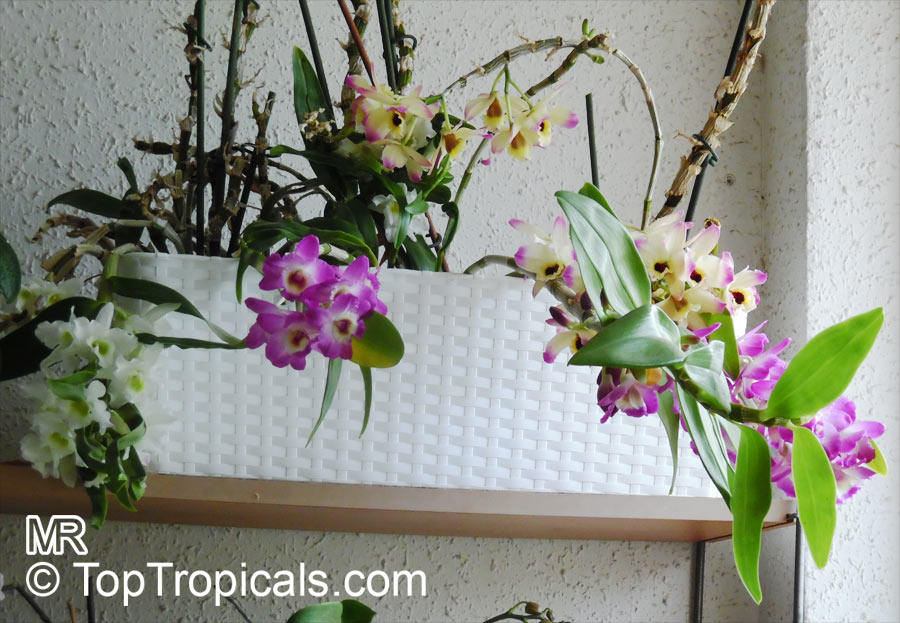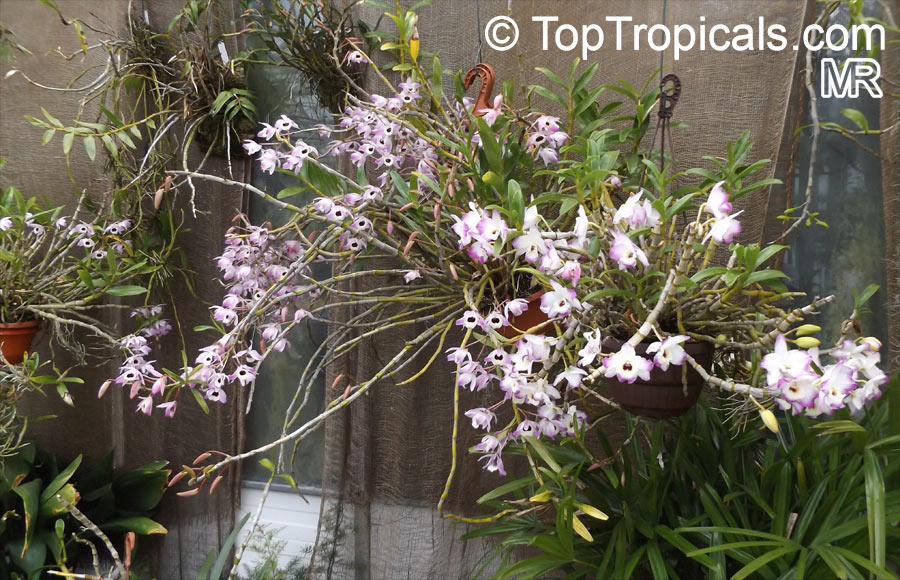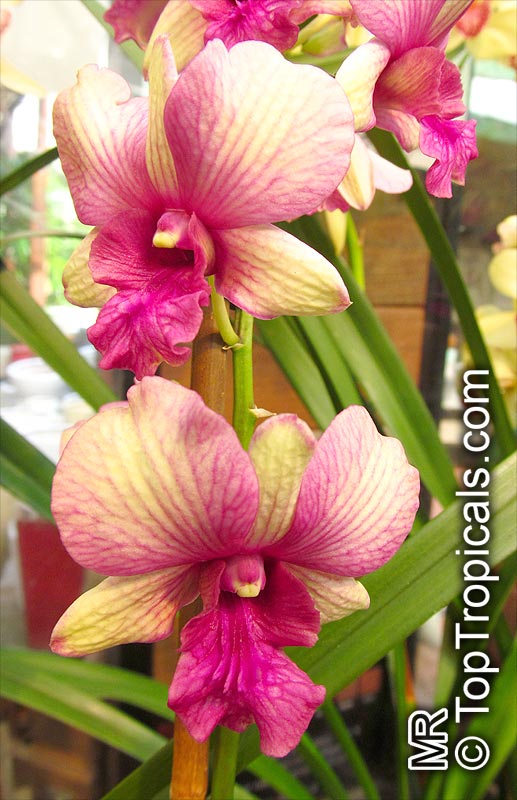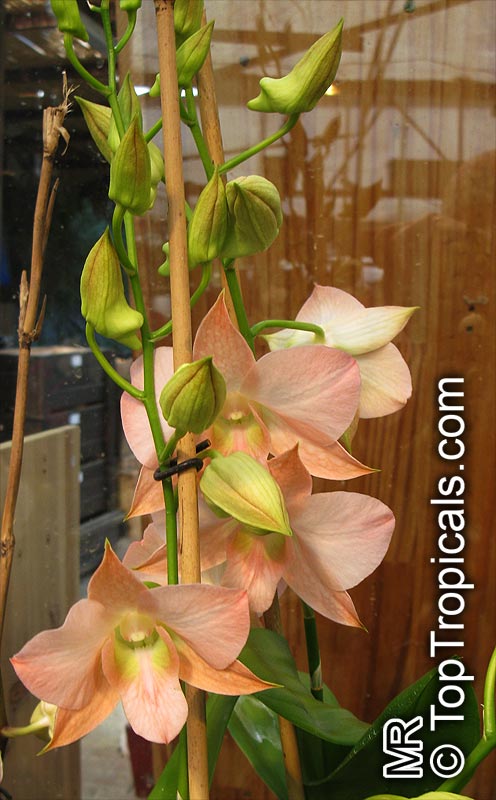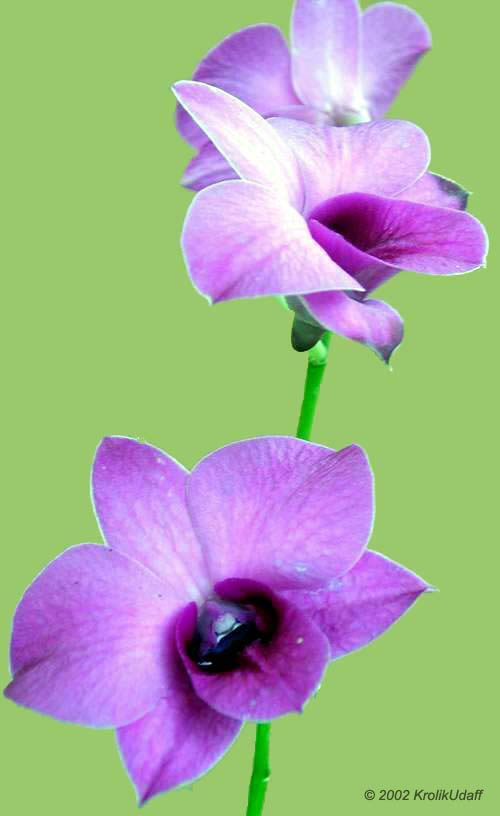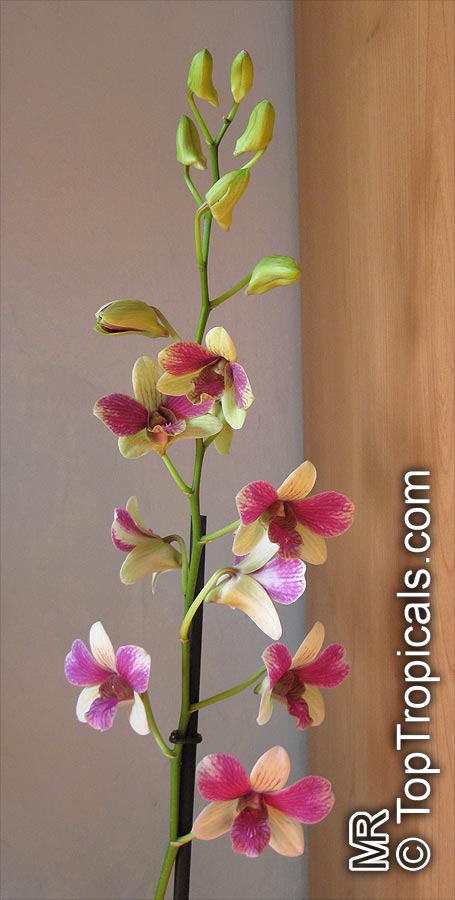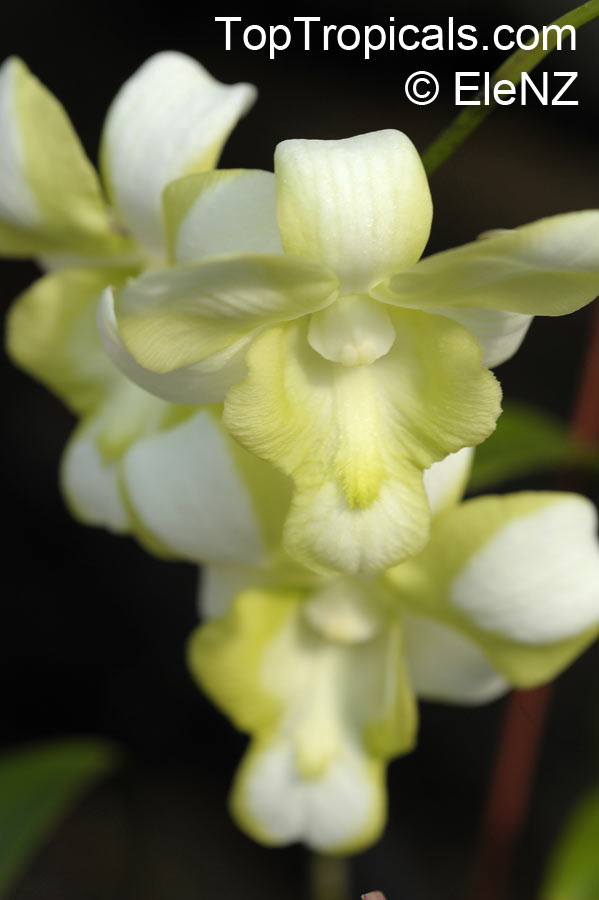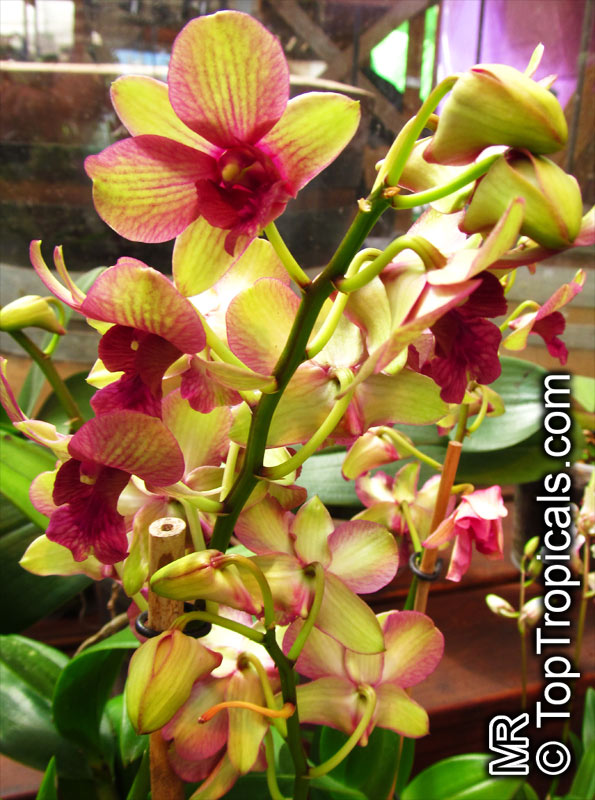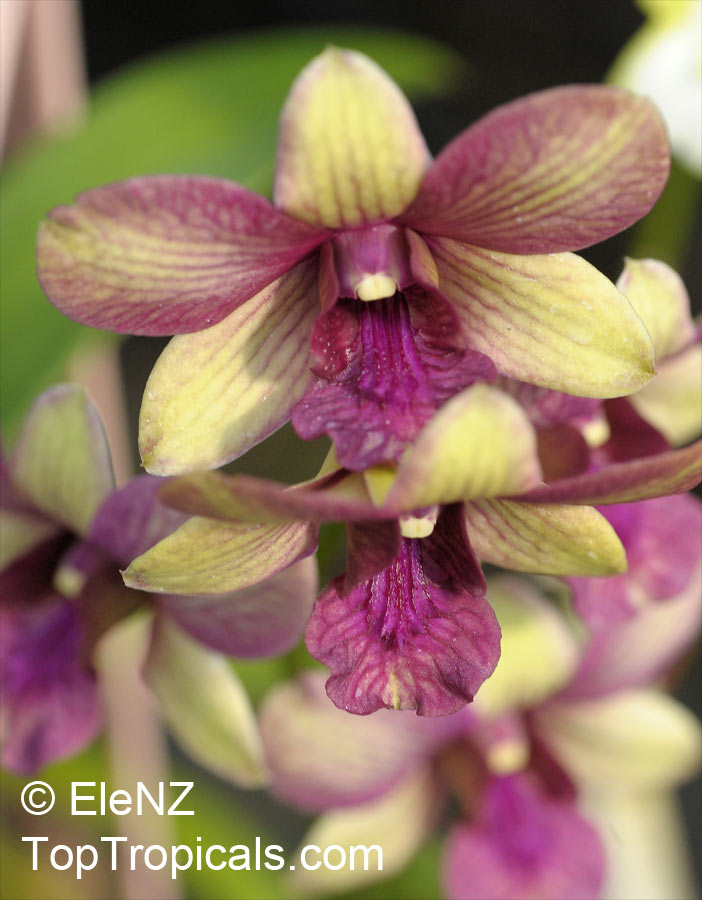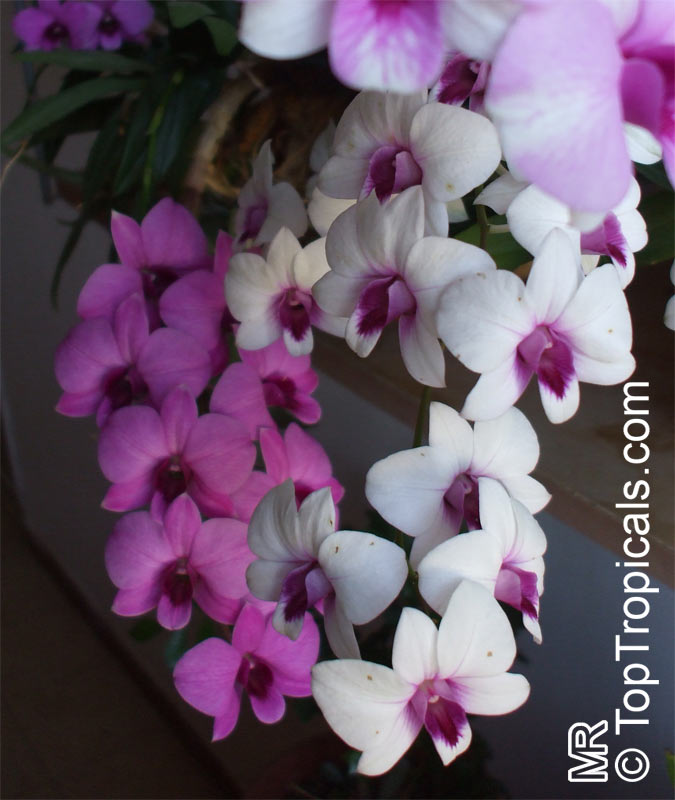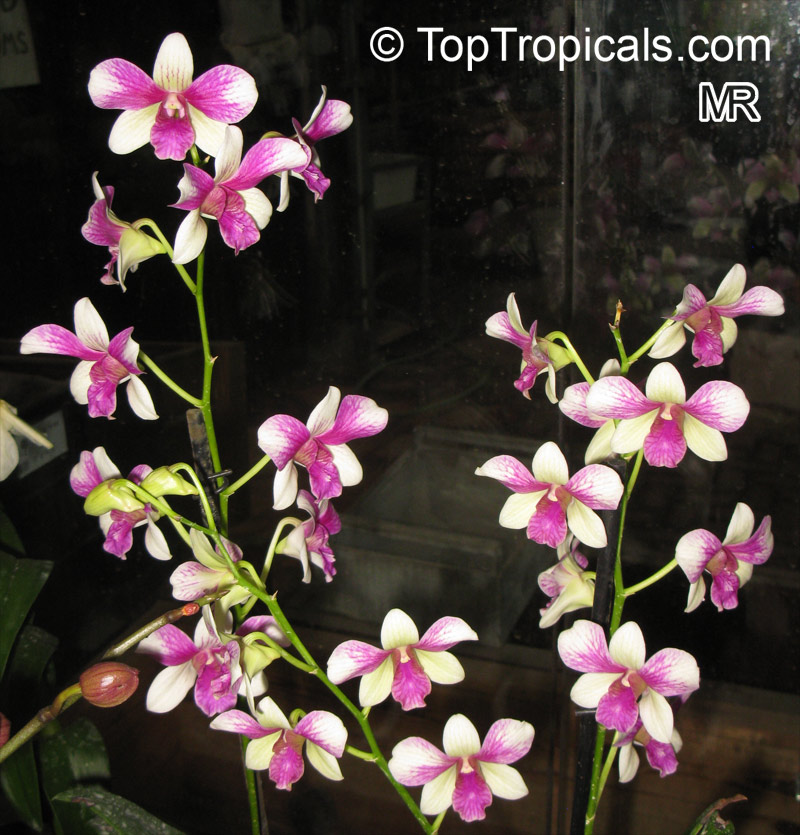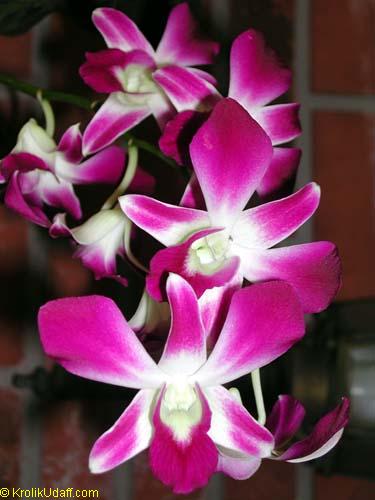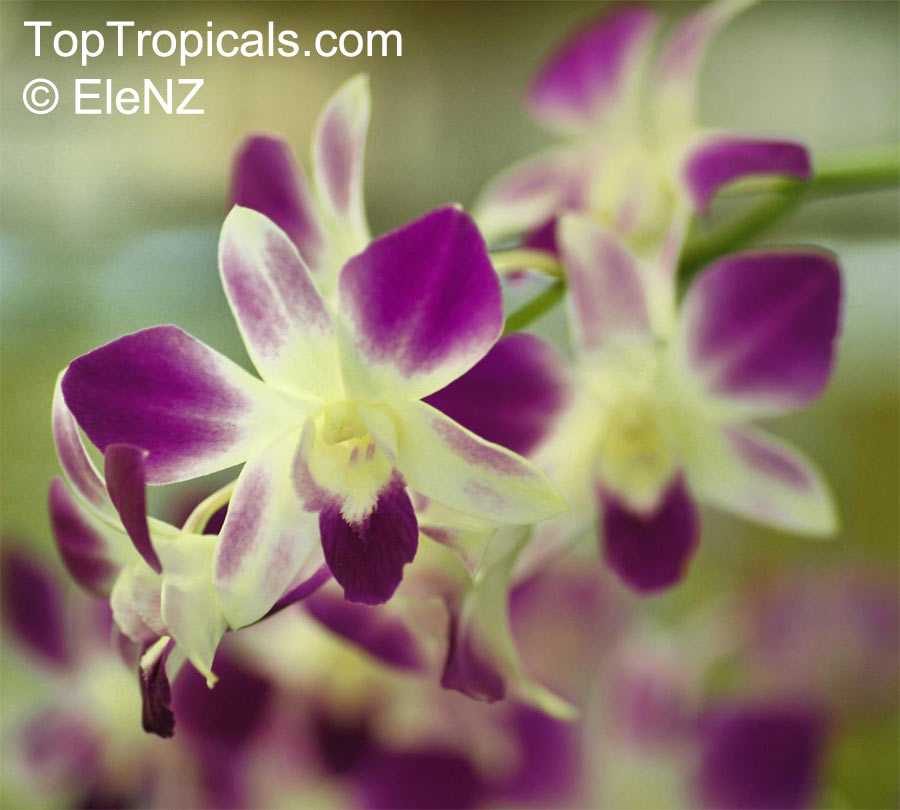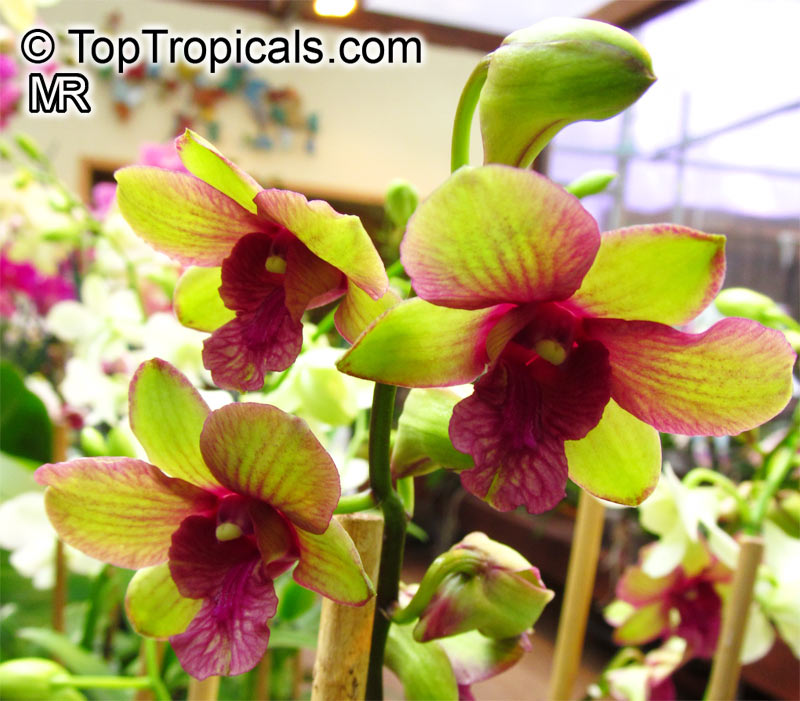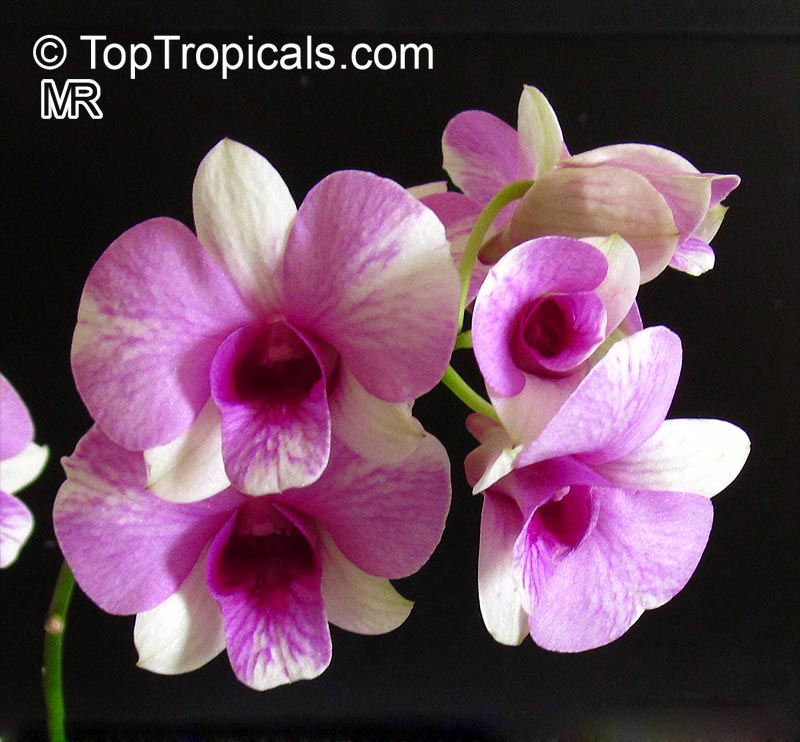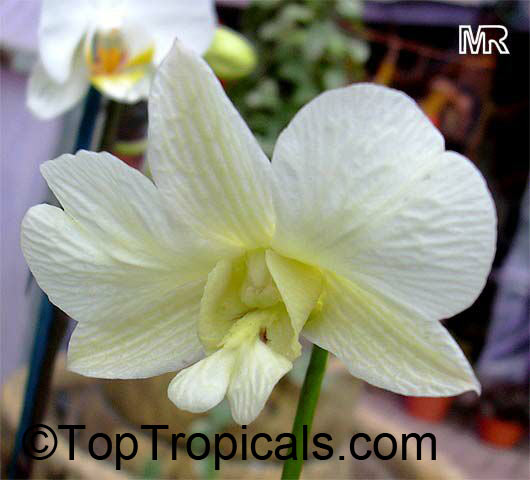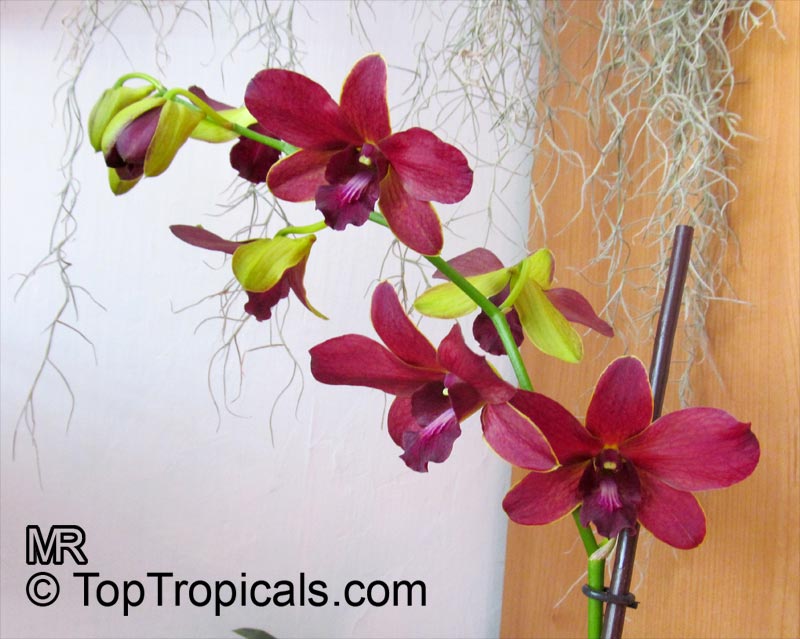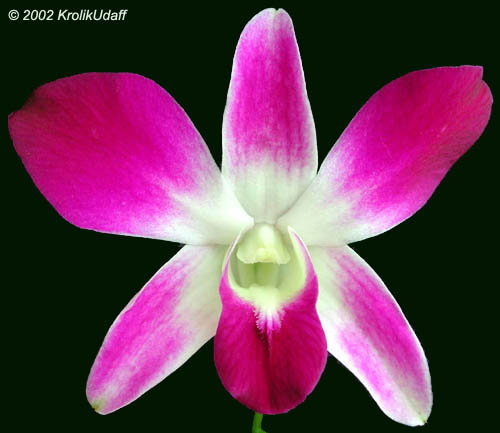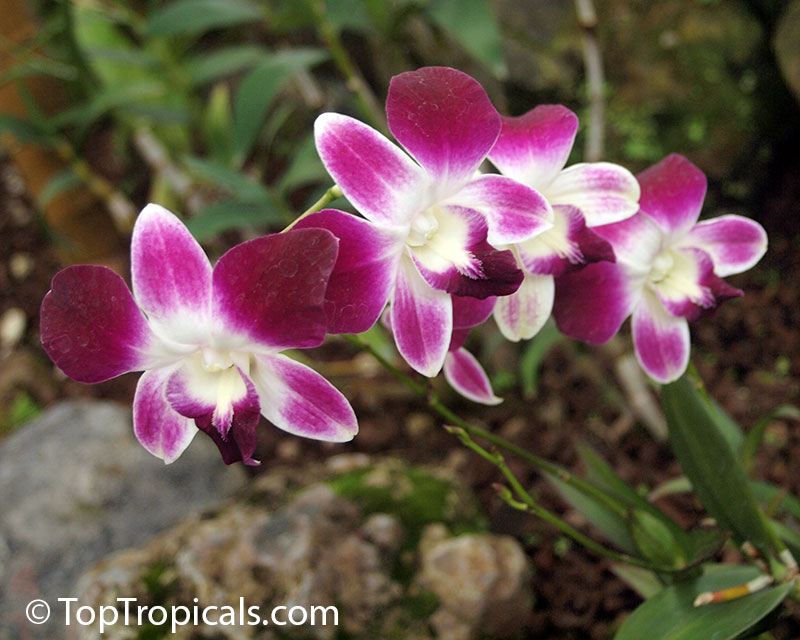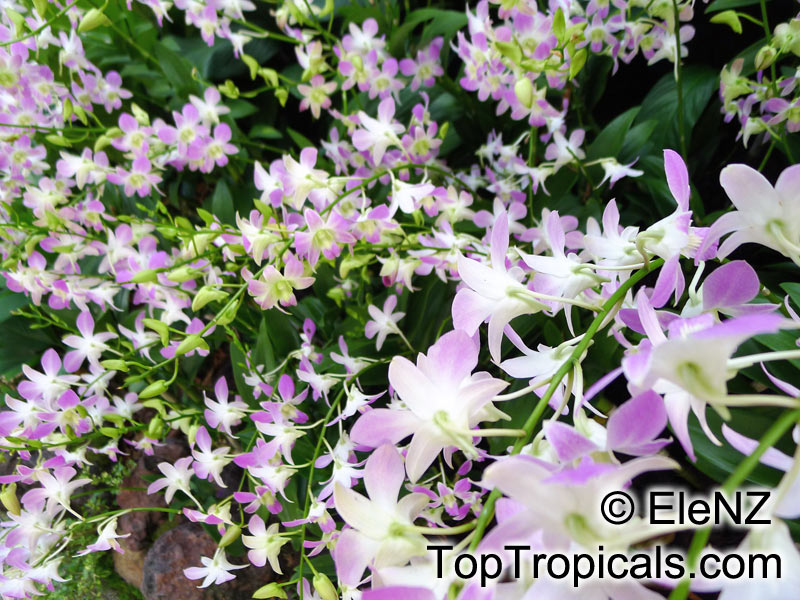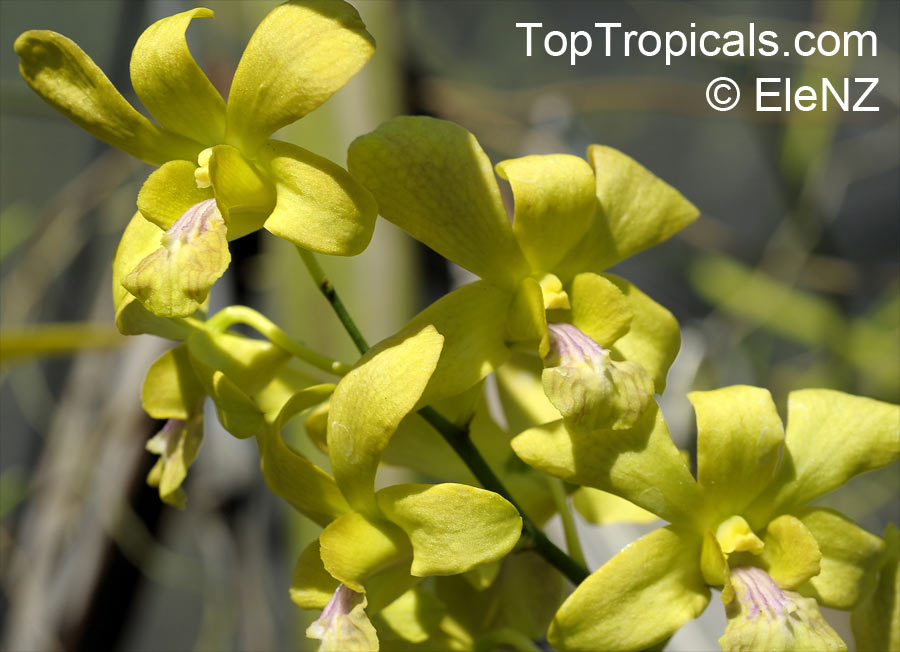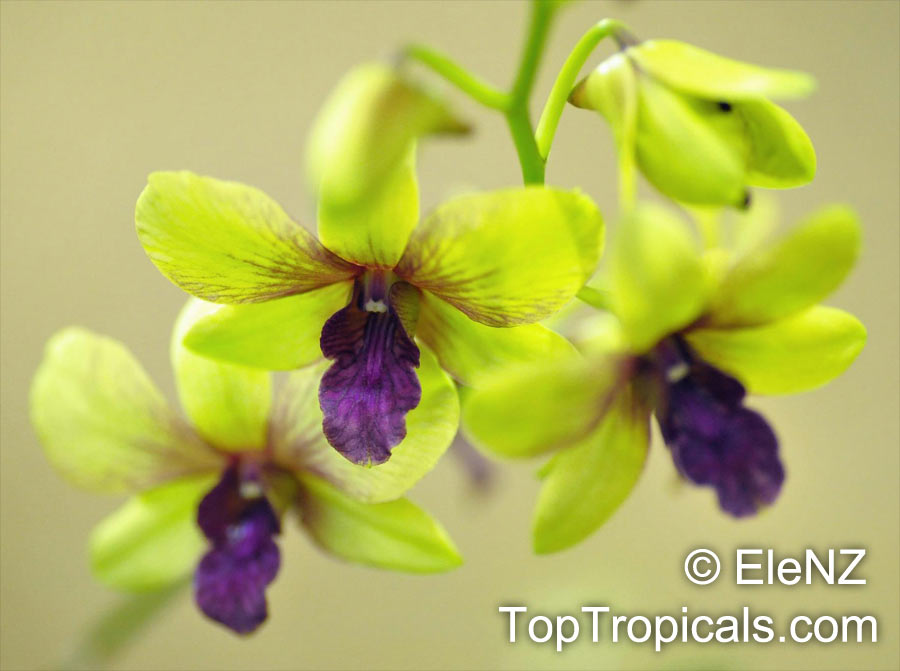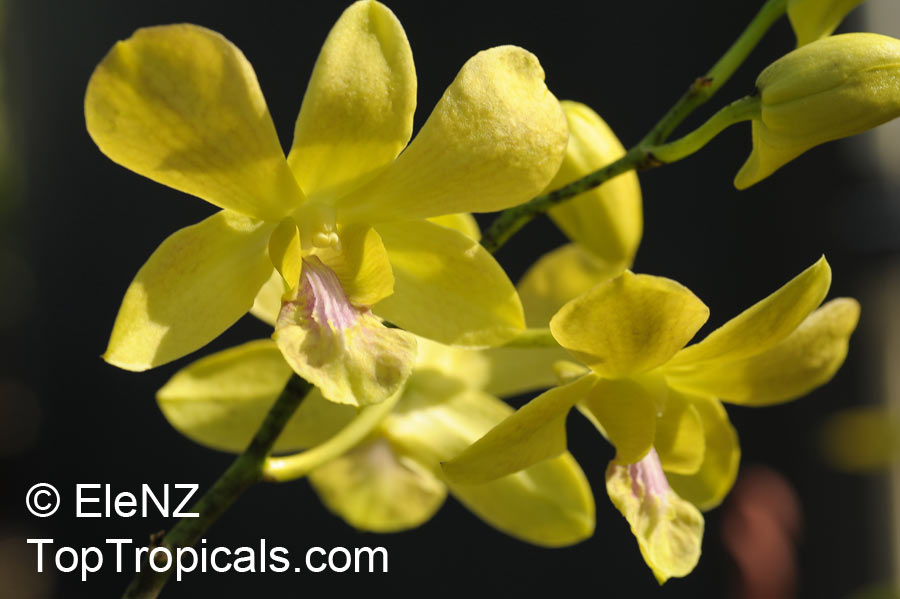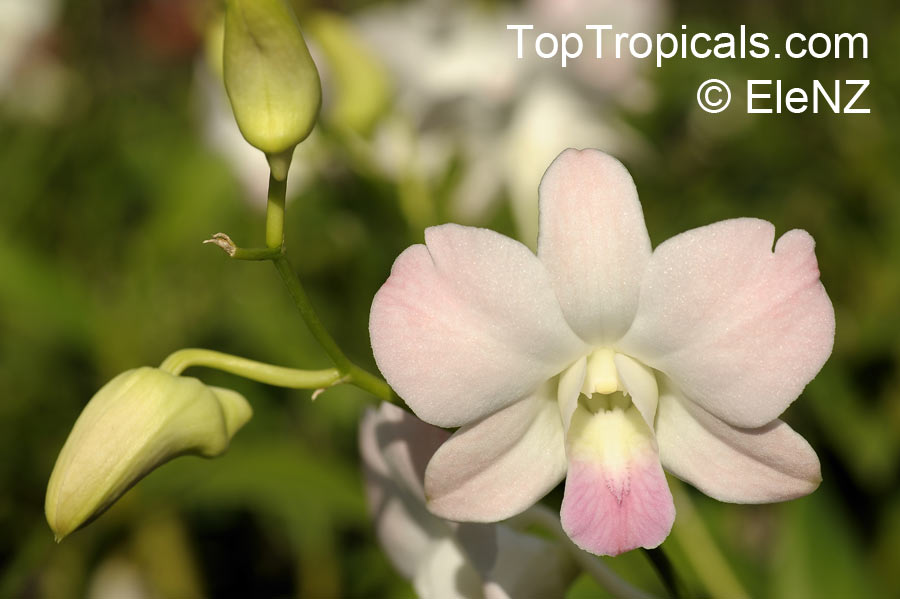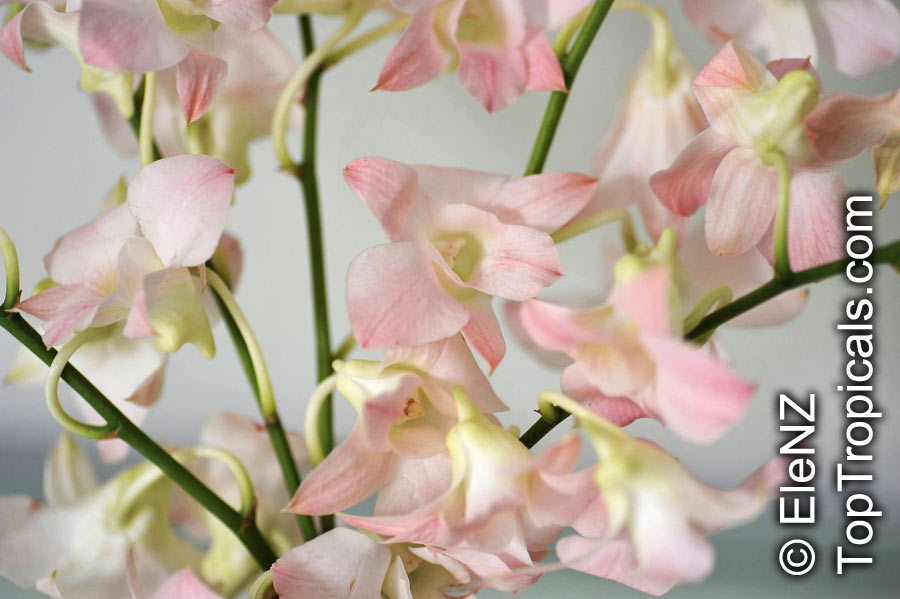Dendrobium - Plant Encyclopedia Results
Top Tropicals Plant Encyclopedia
| Number of plants found: 17 | Next | 
|
Go to page: | 1 | 2 |
Botanical names: Bifrenaria harrisoniae, Dendrobium harrisoniae
Common name: Bifrenaria
Family: Orchidaceae
Origin: South America









Bifrenaria harrisoniae, commonly called Bifrenaria, is a small shrub that grows between 2 to 5 feet in height. Native to South America, this plant is an epiphyte which is known to grow in semi-shade. It is hardy in USDA Zones 9-11 and can be grown both in the ground and in a pot. Bifrenaria produces large, fragrant, pink to white or off-white flowers that attract butterflies, hummingbirds and other pollinators.
The plant needs regular watering to thrive; keep the soil consistently moist, but not overly saturated. If growing in a pot, water regularly during the growing season and less in winter during cold weather to avoid root rot. Bifrenaria planted in cold regions should be kept in a pot and brought indoors during winter months.
If planting in the ground, ensure the soil is well drained and not overly saturated. To best care for your Bifrenaria, add compost to the soil to help with moisture retention. Prune and shape the shrub regularly to give it an attractive appearance and keep it healthy.
In conclusion, Bifrenaria harrisoniae is a small, versatile plant that is easy to care for and can be grown both in the ground and in a pot. It is native to South America and produces fragrant, pink to white or off-white flowers that attract butterflies, hummingbirds and other pollinators. With regular watering and occasional shaping, the Bifrenaria can be a great addition to any garden.
Botanical names: Dendrobium anosmum, Dendrobium superbum
Common name: Fragrant Dendrobium
Family: Orchidaceae
Origin: Southeast Asia







This species has lavender flowers that have two burgundy spots on either side of the lip towards the inner base. An albino form with pure white flowers are available. The long slender pseudobulbs are said to grow to 3 meters (nearly 10 feet) in length. However, in cultivation, especially when it is mounted, the pseudobulbs often do not even reach three feet. The most common type of Dendrobium anosmum is also the most floriferous, it is capable of producing more than sixty flowers on a single cane
Its botanical name anosmum actually means without scent, but Dendrobium anosmum is one of the orchids species with a powerful fragrance.
These plants love high light and benefit from some hours of full sun, some can even stand full midday sun without complaint, however exposing the base of the canes to full sun is deathly for these plants.
Botanical name: Dendrobium bracteosum
Common name: Bracted Dendrobium
Family: Orchidaceae
Origin: Papua New Guinea








The Dendrobium bracteosum is a small plant native to lowland Papua New Guinea. This epiphyte requires an appropriate medium like bark, and it thrives in full sun or semi-shade. The plant loves regular water during grow season and during winter months, it should be watered sparingly to allow it time to rest. It requires high humidity to grow well and is mostly grown mounted or in baskets. The fine roots should be allowed to dry out between waterings to prevent rotting, but the plants should never be allowed to dry too much.
In spring and summer, the plant blooms with beautiful pink or white to off-white flowers. Each inflorescence can carry between 15 and 20 flowers, each with a lifespan of up to 3 weeks. The flowers have a unique wire-like twist to them.
The Dendrobium bracteosum is tolerant of a wide range of temperatures, but it is better to avoid temperatures lower than 50F. While it can be grown outdoors in USDA Zones 9-11, it is better to grow the plant in a pot for extra protection in cold regions. Frost should be avoided, and the pot should be kept in a sheltered location to prevent the roots from freezing.
Botanical names: Dendrobium constrictum, Pedilonum mimiense
Common name: Constricted Dendrobium
Family: Orchidaceae
Origin: New Guinea




Dendrobium constrictum is a small plant, growing between 2 to 5 feet tall with strong upright stems and glossy, pointed leaves. This plant prefers semi-shade and is best grown in hanging baskets or in a pot with a well-draining potting medium. Its easily grown indoors as well and will flower quite profusely, usually with white or off-white flowers that bloom from the top down.
When caring for Dendrobium constrictum, it is important to give the plant enough light and air circulation. The plant prefers temperatures between 70-80 degrees Fahrenheit and should be watered at least once a week as the medium starts to dry out. During the winter months, water less frequently, but make sure it is not allowed to dry out completely.
Overall, Dendrobium constrictum is a unique addition to any indoor or outdoor collection. With its upright stems, glossy leaves and beautiful flowers, this small plant is an ideal choice for those looking for a tropical touch to their home or garden.
Botanical name: Dendrobium densiflorum
Common name: Pineapple Orchid
Family: Orchidaceae
Origin: Asia





Dendrobium densiflorum grows as an epiphyte or sometimes lithophyte in intermediate elevation monsoon forests. Coming from monsoon areas, it requires a dry rest in the winter. The inflorescences arch gracefully downwards, each carrying a large number of flowers, and when open, looking like a bunch of grapes.
Botanical name: Dendrobium fimbriatum
Common name: Fringed-lipped Dendrobium
Family: Orchidaceae
Origin: China, Himalayas, Southeast Asia






The most commonly cultivated form of Dendrobium fimbriatum, variety oculatum is distinguished by its maroon-blotched floral lip. An epiphyte, it typically grows on tree trunks and rock ledges in the wild.
Fringed dendrobium requires partial shade, mild summers, and relatively cool, dry winters.
Botanical name: Dendrobium formosum
Common name: Giant-flowered Dendrobium
Family: Orchidaceae
Origin: Himalayas, Southeast Asia





Dendrobium formosum has a very large and stately flower that is pure white with contrasting yellow-orange markings in the center of the lip.
Dendrobium 'Dawn Maree' (Den. formosum x Den. cruentum)
Dendrobium 'Frosty Dawn' (Den. 'Dawn Maree' x Den. 'Lime Frost')
Botanical names: Dendrobium lindleyi, Dendrobium aggregatum
Common name: Dendrobium
Family: Orchidaceae
Origin: Southeast Asia





A native to Southeast Asia, Dendrobium lindleyi is a small plant, growing to a maximum of 2-5 feet. It requires semi-shade and moderate water. Its growth is an epiphyte, meaning it grows on a host plant, rather than in soil. It can bloom several times throughout the year, bearing flowers in colors of yellow, orange, and even brown. It is well adapted to subtropical climates and can be grown in USDA Hardiness Zones 9-11.
When it comes to growing Dendrobium lindleyi, it is important to know that it is a short-day or winter-blooming plant. During the day, the temperature should range from 65-75 degrees Fahrenheit, while at night it should be around 50-60 degrees. Watering should be moderated, as the plant can rot if too much is given. Fertilizing should be done monthly, using a well-balanced plant fertilizer.
For those who live in colder regions, it is still possible to grow Dendrobium lindleyi in a pot, but that does require some extra care. The potting mix should be well aerated and have good drainage. This is particularly important for orchids, as they need well-draining soil. It is also important to not let the potting mix dry out completely. During the summer months, provide bright but indirect sunlight and water sparingly. In winter, move the pot to a slightly cooler area and reduce the frequency of watering. This will enable the plant to go dormant and rest. It does not require any pruning or shaping either, just enough water, nutrients, and sunlight for it to thrive.
Botanical name: Dendrobium nobile
Common name: Dendrobium Nobile Orchid
Family: Orchidaceae
Origin: Southeast Asia







Native to Southeast Asia, Dendrobium nobile, also known as Nobile Orchid, is a semi-shady plant requires moderate water and the medium to bright light in order to thrive the best. It is hardy in USDA Zone 9-11. The flower of the Dendrobium nobile is quite a sight to behold with its beauty and vibrant range of colors. It bears a myriad of shades including pink, white, off-white, blue, lavender, purple, yellow and orange. The colorful and fragrant blooms appear as clusters of several flowers opposite the axil of each leaf.
Taking care of Dendrobium nobile is relatively easy and simple. Although, the plant can stand a lot of light, it is important to keep it within indirect sunlight to avoid the leaves from getting scorched. While watering, ensure that the medium is semi-dry and water it moderately. Moreover, fertilize your plant once every four weeks with liquid balanced fertilizer.
In cold regions, Dendrobium nobile can also be grown in pots as an indoor houseplant. However, they require bright light and cool temperature in order to thrive in such conditions. During the winter, the plant should have periods of dormancy. Just make sure it is kept moist and away from chill.
Botanical name: Dendrobium phalaenopsis
Common name: Dendrobium
Family: Orchidaceae











Dendrobium phalaenopsis is a small shrub that grows 2-5 ft tall with a spread of up to 2 ft. It is an epiphyte, which means it does not require soil to survive. It does, however, prefer moderate water and needs to be kept moist. It can thrive in full sun and semi-shade, but if the temperature rises too high, it will need more shade.
When it comes to blooms, Dendrobium phalaenopsis has wide variety of colors. It produces pink, white and off-white flowers in abundance and might also surprise the gardener with the more unusual colors of blue, lavender, purple and even red, crimson, or vinous. The flower can also come in yellow and orange.
Grown in USDA Zone 9-11, Dendrobium phalaenopsis is an easy to grow orchid and will give rarely give the gardener issues when planted in pots in cold regions. If the temperature in a given area is prone to dipping below freezing, it is recommended that the pot be moved indoors where temperatures can be maintained at 65°F or higher. Additionally, the plant should be watered regularly and the soil kept slightly moist. Fertilizing should also be done in moderation.
| Next |  |
Use link to repeat this search:
https://toptropicals.com/cgi-bin/garden_catalog/cat.cgi?find=Dendrobium&search_op=and&keyword_op=and&language=e&number=10
&no_change_lang=1&user=tt&sale=1&first=0
